Athletics
Athletics ray Wed, 04/21/2010 - 09:47- 1790 views
Baseball
Baseball ray Wed, 04/21/2010 - 09:49- 705 views
Early 1900? OCEAN SPRINGS NINE [Roy Bland image]
The first recorded baseball game at Ocean Springs occurred in May 1875, only a few years after the first professional league was organized in the United States. In 1876, the National League commenced
1875 Ocean Springs
The contest played at Ocean Springs on Sunday May 16, 1875, was between the local club, Hope B.B.C. [Base Ball Club], and the R.E. Lee B.B.C. of Biloxi. Biloxi won 5-4 in the nine innings game. The Ocean Springs squad was manned by Thomas A. Cochran (1852-1883), pitcher; Richard Egan (18 -1898), 3rd base; Ralph Bellman (1856-1899), 1st base; J. Soden, catcher; John Clark, 2nd base; John Egan, shortstop; Louis Ryan (1837-1909), right field; John Franco; C. Ryan, centerfield; and John Ryan (1856-1920), left field.
Biloxi team: L. Beaugez, 1st base; Francis Caillavet (1856-1909), pitcher; Monroe Ritch (1852-1919); J.L. Henley, 3rd base; W. Gill, centerfield; F. Dejean, right field; J.W. Henley, catcher; Ernest Desporte (1853-1931), J. Llado, and D. Lang, left field.
First public park
In May 1896, a group of Ocean Springs citizens assembled in the Knights of Pythias Hall at the urging of the Bicycle, Gun, and Baseball Clubs to form a stock company, which became known as the Ocean Springs Park Association. Their salient goal at this meeting was to acquire land for a public park. The Columbian Band was present for the occasion and performed several tunes. Major F.M. Weed (1850-1926) led the attendees and Dr. E.R. Bragg, performed his secretarial duties. The group was addressed by civic leaders, Joseph Kotzum (1842-1912), H.F. Russell (1858-1940), as well as, Mr. Weed and Dr. Edward Reneau Bragg (1862-1916). A land acquisition committee was appointed to buy a large tract of land east of town on Old County Road, now Government Street, from Capitan Silas Weeks (1823-1901). George W. Davis (1842-1914) chaired this committee.(The Pascagoula Democrat-Star, May 22, 1896, p. 3)
At its May 1896 gathering, the Ocean Springs Park Association held elections and the following officers were voted into office: Joseph Kotzum (1842-1915), president; H.F. Russell (1858-1940), T.W. Grayson (1825-1904), and B.F. Joachim (1853-1925), vice presidents; Dr. E.R. Bragg (1862-1916), secretary; and W.S. VanCleave, treasurer. The board of directors at this time consisted of: Augustus von Rosambeau (1849-1912), John Duncan Minor (1863-1920), George W. Davis (1842-1914), T.P. Franco (1878-1938+), J. Soule, Emile Domning (1850-1918), George H. Tardy (1839-1902), H.F. Halstead (1869-1916+), Frederick Buttner (1826-1903), F.M. Weed (1850-1926), and Ross A. Switzer (1875-1945). In addition, four hundred dollars of stock was sold and plans were established to commence immediately on a public park.(The Pascagoula Democrat-Star, June 5, 1896, p. 3)
First park site
In September 1896, Silas Weeks (1823-1901) conveyed to the Ocean Springs Park Association, 15.35 acres in the NE/4 Section 29, T7S-R8W, for $15.12. A plat of tract made by E.N. Ramsay in July 1896. E.W. Illing was secretary of the association at this time.(JXCO, Ms. Land Deed Bk. 18, pp. 87-88)
Sale
In August 1904, the Ocean Springs Park Association to Birdie E. Anderson Bailey (1876-1925), the spouse of Dr. O.L. Bailey (1870-1938). Consideration $380.00.(JXCO, Ms. Land Deed Bk. 28, pp. 461-463)
The Johnsons of Algiers
In the summer of 1899, Mr. F.O. Johnson and daughters, Misses Antoinette and Carrie, were staying at the Artesian House on Jackson Avenue.(The Pascagoula Democrat-Star, August 18, 1899, p. 3)
In August 1904, B.E. Bailey to Henrietta H. Johnson, for $570.00.(JXCO, Ms. Land Deed Bk. 28, pp. 495-496). On August 27, 1904, The Progress announced that
“F.O. Johnson purchased the old Park, about a mile from town one day this week from Dr. Bailey. Mr. Johnson will make Ocean Springs his home”.
Henrietta Hedman Johnson (1855-1922) was the wife of Danish sea captain, Frederick Oliver Johnson (Jenson) (1851-1938), from Algiers, Louisiana. They were the parents of two daughters, Antoinette Emma Johnson (1870-1956) and Carrie Ann Johnson (1886-1968).
Antoinette E. Johnson married Frank E. Schmidt circa 1900. He worked as an oysterman until January 1901, when he took a lease from the F.J. Lundy Company on the Illing Bakery property located at 78-80 Washington Avenue. Mother of Frank, Harry and Ernest Schmidt. To Ocean Springs what the Anderson brothers in art world!!
Carrie Ann Johnson (1886-1968) who was married to Joseph B. Garrard (1871-1915), and Alexander Fleet Everhart (1881-1957). Mrs. Everhart was in the hardware business, grew citrus fruit, and dealt in real estate at Ocean Springs. Mr. Johnson ran a grocery store on Washington Avenue in 1910.
The Samuel P. Starks Family
In February 1908, F.O. Johnson to Isabella Latimer Starks (1863-1936), the daughter of Edwin Latimer and Mary Krohn, for $1600 cash.(JXCO, Ms. Land Deed Bk. 33, p. 224)
In February 1886, she married Samuel P. Starks (1860-1919). Their children were: Margaret S. (J.Y.) Morgan (1886-1939+), Catherine S. (Peter E.) Quave Jr. (1888-1940), William Starks (1894-1894), Theresa A. Starks (1890-1968), Elisabeth Starks (b. 1892), Mary Camilia S. Murphy (1895-1939+), James P. Starks (1898-1987), Cyril A. Starks (1900-1903), Edwin G. Starks (1903-1939+), Lillian Starks (1905-1939+), and Samuel P. Starks II (1906-1993).
Samuel P. Starks made his livelihood as a butcher. His residence and meat market were situated on the east side of Washington Avenue between County Road, now Government Street, and Bowen Avenue, in Lot 25 and the S/2 of Lot 26 of the Clay Strip. The Salvetti Brothers’ Restaurant is situated here today. Samuel P. Starks acquired this now valuable commercial site from the widow, Julia Egan (1833-1907) and her three sons, in August 1882, for $125. (JXCO, Ms. Land Deed Bk. 33, pp. 226-227)
In December 1904, Samuel P. Starks was Marshall elect of Ocean Springs. He defeated Casper Vahle (1867-1922) by twenty-five votes, 68 to 43.(Town of OS, Minute Bk. 2, pp. 301-302)
One complaint heard just prior to Marshall Starks taking office was the indiscriminate use of firearms within the perimeter of Ocean Springs, especially on the east side.(The Progress, October 1, 1904, p. 4)
Oak Park-Ames Tract
A very early baseball field at Ocean Springs was situated in the Ames Tract located in Section 19, T7S-R8W.
The forefather of the Ames family at Ocean Springs was John Ames (1797-1852+). Ames settled originally at New York (1843) and came to Ocean Springs circa 1845 where he made his livelihood as a collier (charcoal maker). Ames secured land patents in 1847 and 1848 from the United States Government on one hundred-twenty acres of land in the SE/4 of Section 19, T7S-R8W.
This parcel of land, known in the past as the "Ames Tract", was bounded on the north by the south line of the SW/4 of the NE/4 of Section 19 (which strikes east-west through the southern one-third of the Evergreen Cemetery) and a line south of Iberville through the Spring Plaza Shopping Center, west by a line projecting from Government through Blount to Fort Bayou, south by Government, and east by a line from Government to the east side of the Spring Plaza Shopping Center. Oddly, Ames Avenue is just west of the original Ames Tract.
Baseball Green
Probably, the first baseball park at Ocean Springs, called the "Baseball Green" was located on a part of the Ames Tract. It was 763 feet by 363 feet (6.36 acres) and located west of present day Chandler’s Restaurant, formerly Germaine's Restaurant and Trilby’s on Bienville Boulevard. Captain Antoine Bellande (1829-1918) purchased the tract from James Stranby of New Orleans in November 1873.(JXCO, Ms. Land Deed Bk. 39, pp. 208-210)
It later became known as Veillon's Ball Diamond after Mrs. Henrietta Hyde Veillon (d. 1920) bought it from Bellande in May 1913.(JXCO, Ms. Land Deed Bk. 39, p. 328-329)
After the Ocean Springs Brass band was reformed in March 1915, concerts were on the agenda for Marshall Park and for home baseball contests. Officers elected to revise this unit were: George L. Friar, president; R. Carver, vice-president; George Pabst, secretary; I.W. Simmons, treasurer; and Theo Ames, band director.(The Ocean Springs News, March 25, 1915, p. 1)
John M. Gehl of New Orleans acquired the baseball lot in May 1917, from A.T. Veillon. His father-in-law, William T. Pierson, an experienced farmer and orchardist, lived on the place.(The Jackson County Times, May 19, 1917)
In July 1920, Mr. Gehl began fencing in the field to serve as a pasture for his dairy herd. He allowed baseball games with the caveat that the cows not be disturbed and that the baseball games be played without violent or obscene outbursts.(The Jackson County Times, July 24, 1920, p. 3)
In June 1921, John M. Gehl ordered the baseball green off limits. Repeated abuses to his fences by players and spectators angered him to force closure of the baseball field. The diamond was ideally located and the town was certainly the losers.(The Jackson County Times, June 25, 1921, p. 4)
By the summer of 1922, Gehl Field was again used for baseball. In late June, a Fireman’s Boomerang or all-day picnic was held in the new dance pavilion at the park. The event was held to raise funds for the mortgage on the new fire hall. This venue was used by several politicos to champion their candidacy in the coming elections. Governor Lee Russell (1875-1943) was among them.(The Daily Herald, June 22, 1922, p. 3)
It later became known as Veillon's Ball Diamond after Mrs. Henrietta Hyde Veillon (d. 1920) bought it from Bellande in May 1913.(JXCO, Ms. Land Deed Bk. 39, p. 328-329)
Dr. Henry Bradford Powell (1867-1949), a Canadian physician and inn keeper, operated a four hole golf course here in 1910. The links were short lived as Powell with A.E. Lee (1874-1936) and George E. Arndt (1857-1945) developed the Ocean Springs Country Club on the Rose-Money Farm north of Fort Bayou in 1914.(The Ocean Springs News, January 22, 1910, p. 5, and , July 1910?
Dr. Powell was obviously an avid golfer. He probably also saw the game as an attractive activity for the patrons of his sanitarium and later Bayou Inn. In 1910, Powell made arrangements to layout a seven hole course on what was known as the Baseball Green. By July 1910, a four hole course was in place on the ball grounds.
The Baseball Green was a 6.36 acre tract located north of the L&N Railroad on the Ames Tract in the vicinity of present day Germaine's Restaurant. Captain Antoine V. Bellande (1829-1918) owned the land at the time of Powell's foray into the golfing world. In May 1913, Bellande conveyed the tract to Henrietta E. Veillon (d. 1920), the wife of Alceide Veillon (1862-1949). Later Ocean Springs baseball nines played here at Veillon's Park.
Although the local golf course on the Baseball Green was apparently short-lived, Ocean Springs was smitten with the game of golf. In late March 1914, an organizational meeting was held in the office of The Ocean Springs News to commence the Ocean Springs Country Club. Dr. Powell was elected president, Albert E. Lee (1874-1936), secretary, and George E. Arndt (1857-1945), treasurer.
The Ocean Springs Country Club was incorporated in the summer of 1914, for $10,000. There were twenty-four charter members who became a holding committee for the club. Membership was open to anyone in the community in good standing. Monthly dues were $1.00 and the initiation fee $25.00.
1915 brass band
After the Ocean Springs Brass band was reformed in March 1915, concerts were on the agenda for Marshall Park and for home baseball contests. Officers elected to revise this unit were: George L. Friar, president; R. Carver, vice-president; George Pabst, secretary; I.W. Simmons, treasurer; and Theo Ames, band director.(The Ocean Springs News, March 25, 1915, p. 1)
A.T. Veillon
In August 1922, Alceide T. Veillon (1862-1949), a native of New Orleans, bought Lots 1, 2, 3, and 4 of Block 5-Alto Park Addition from the heirs of Jane E. Meacher for $800.(1) Meacher was probably from Wisconsin. She had obtained the property from M.E. Curtiss and Emma Rudd Powell (1860-1936), the wife of Dr. Henry Bradford Powell (1867-1949), in April 1906.(2)
A.T. Veillon came to Ocean Springs from New Orleans circa 1890. At the time, he was married to Henrietta "Cora" Hyde (1863-1920), a native of Vermont. They married circa 1885, probably at New Orleans. Her father was English. At Ocean Springs, Veillon made his livelihood as a hack driver (1900), meat market operator on Washington Avenue (1910), and later he ran a billiard hall in the old Lundy Building on the southeast corner of Washington and Government.
After the death of Cora Hyde Veillon in 1920, Alceide married Antoinette Haas (1869-1953). Circa 1924, they built a cottage at present day 300 Ward Avenue, which became known as the "Veillon honeymoon cottage".
John M. Gehl and William T. Pierson
John M. Gehl of New Orleans acquired the baseball lot in May 1917, from A.T. Veillon. His father-in-law, William T. Pierson, an experienced farmer and orchardist, lived on the place.(The Jackson County Times, May 19, 1917)
He was married to Esther Morris Gehl of New Orleans in February 1924. (Jackson County Times, February 9, 1924) She was the daughter of John M. Gehl, who had purchased the A.T. Vellion (1862-1949) place in May 1917. Gehl’s father in law, William T. Pierson, occupied the site called “Gehl Villa”. He was experienced in fruit and vegetable culture. (The Jackson County Times, May 19, 1917)
The old Veillon-Gehl home is now Chandler’s Restaurant, formerly Germaine’s and Trilby’s Restaurant on Bienville Boulevard. Mr. Elizardi’s brother, Ralph Elizardi (1912-1997), an engineer, retired to Ocean Springs, where he was active in the local art community. Ralph took precise and vital measurements from the hull, mast, booms, and sail of the Royal Flush and had architectural plans prepared to preserve the craft’s design for future generations of sailors. He also saved old photographs of the swift racer.
In July 1920, Mr. Gehl began fencing in the field to serve as a pasture for his dairy herd. He allowed baseball games with the caveat that the cows not be disturbed and that the baseball games be played without violent or obscene outbursts.(The Jackson County Times, July 24, 1920, p. 3)
Field closes-reopens
In June 1921, John M. Gehl ordered the baseball green off limits. Repeated abuses to his fences by players and spectators angered him to force closure of the baseball field. The diamond was ideally located and the town was certainly the losers.(The Jackson County Times, June 25, 1921, p. 4)
By the summer of 1922, Gehl Field was again used for baseball. In late June, a Fireman’s Boomerang or all-day picnic was held in the new dance pavilion at the park. The event was held to raise funds for the mortgage on the new fire hall. This venue was used by several politicos to champion their candidacy in the coming elections. Governor Lee Russell (1875-1943) was among them.(The Daily Herald, June 22, 1922, p. 3)
1922 Team
In 1922, there were two baseball squads at Ocean Springs. The “Regulars” was managed by
High School baseball
How did the Greyhounds get named? Miss Mary C. O’Keefe described the football team as “light and fast like a greyhound.” (Lurline Schrieber Hall, June 15, 2004)
1915 Mississippi Coast League
The Mississippi Coast Amateur Baseball League was organized in February with teams from Biloxi, DeLisle, Gulfport, and Ocean Springs participating. The following officers were elected: James Lynch of Gulfport- president; T.W. Dabney of Ocean Springs-vice president; O.A. Porter of Gulfport-secretary-treasurer. The Ocean Springs team was manned by: Harry Westbrook (1894-1933), catcher; Bill Horton, catcher; Emile Ladnier, pitcher; Oscar Davis, pitcher; W. Ryan, infielder; Minor Russell, infielder; Justin Ryan (1889-1963), infielder; Mark Lee (1898-1990), infielder; R. Mons, outfielder; Everett McKay, outfielder; Dan Van Court (1885-1943), outfielder; F.L. Westbrook, outfielder. Others: Frank K. Ryan; Aurie Beaugez; Herbert Beaugez; Edward Ladnier; James Colligan; and Alphonse Cox. In their first game, Ocean Springs lost by a forfeit to Biloxi, when the team left the field in the 7th inning because Biloxi fans would not move away from the sidelines. Biloxi led 5 to 4.(The Gulfport Advocate, February 20, 1915, p. 4, March 6, 1915, p. 4, and April 10, 1915, p. 7)
Ocean Springs led the league in late April 1915 with a 3-1 record.(The Ocean Springs News, April 29, 1915, p. 3)
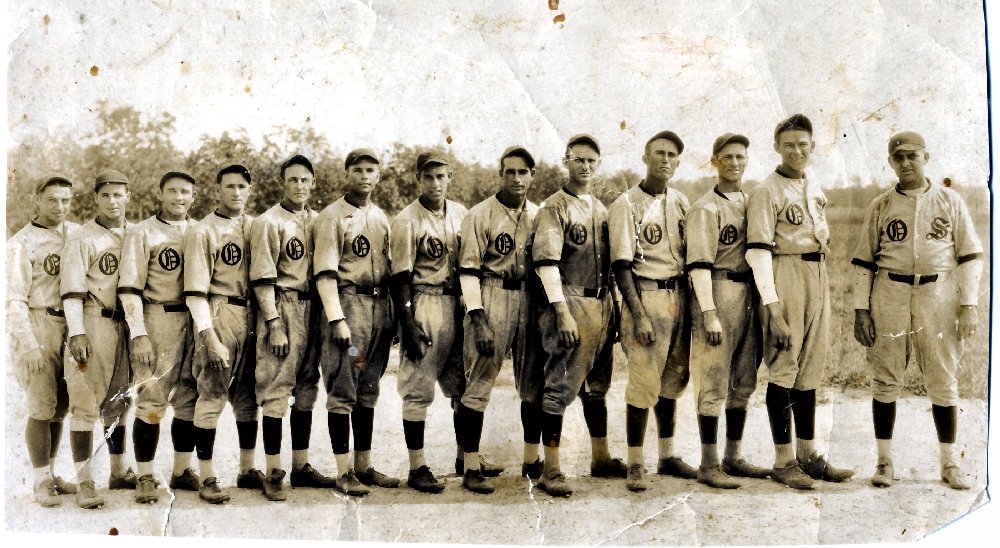
1928 Champions
Courtesy of Anthony "Tony" F. Catchot
(l-r: unknown; B.F. Joachim III (1908-1974); Dan Newcomb (1906-1967); Anthony "Tony" F. Catchot (1907-1996); unknown; Bernard VanCourt; George Bisso (1911-1959); Vincent Lechner (1901-1979); Leroy M. Westbrook (1907-1989); Percy Larsen (1905-1984); Tom Clark; and Harry J. Westbrook (1893-1933), Manager and Coach.
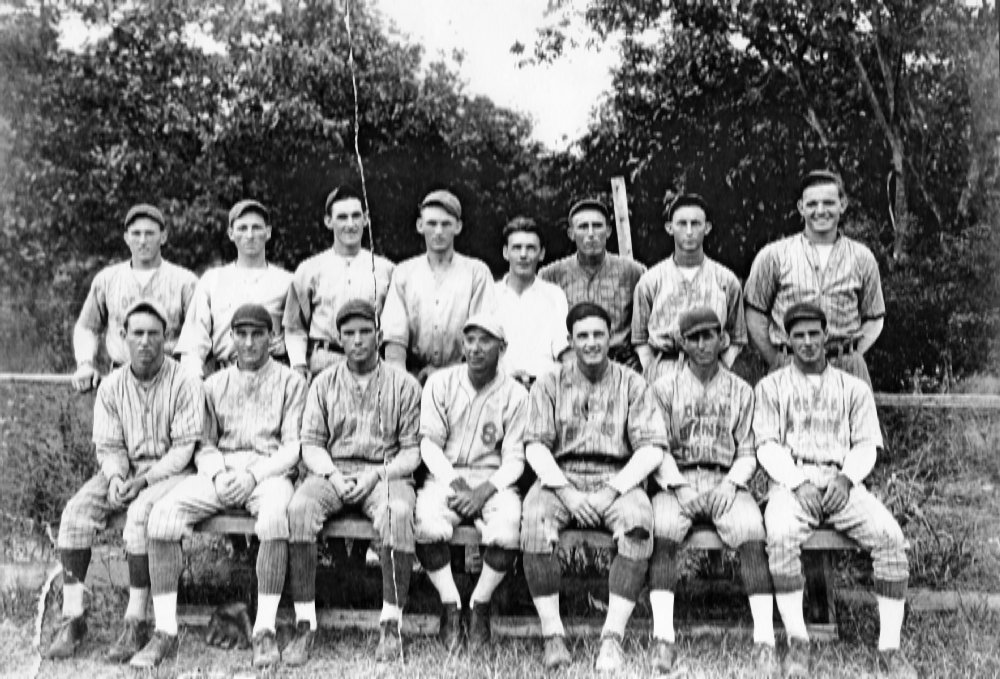 1929 Champions
1929 Champions
(standing: l-r: Anthony "Tony" F. Catchot (1907-1996), left field; Percy Larsen (1905-1984), second base; Herman McGee, center field; Leroy M. Westbrook (1907-1989), catcher; Mark Oscar Joachim (1904-1955), Club President; Leo Webb, pitcher; Rollin "Polly" Stanley Armstrong , first base; and Claude W. Passeau (1909-2003), pitcher.
(seated: l-r: Kiernan, pitcher; Morris "Babe" Baker (1907-1994), right field; Bernard VanCourt, first base; Charles R. Bennett (1884-1971), Manager; Dan Newcomb (1906-1967), third base; Beaugez, utility; and B.F. Joachim III (1908-1974), shortstop.
1934 Baseball Park
REFERENCES:
Journals
The Daily Herald, “Ocean Springs To Have Banner Day”, June 22, 1922.
The Daily Herald, “Biloxi and Ocean Springs to Meet in Titular Title”, June 10, 1929, p. 5.
The Daily Herald, “Ocean Springs Wins First half Championship Title”, June 17, 1929, p. 6.
The Daily Herald, “Biloxi and Ocean Springs to Meet in Titular Title”, June 10, 1929, p. 5.
The Daily Herald, “Ocean Springs Wins First half Championship Title”, June 17, 1929, p. 6.
The Daily Herald, “Ocean Springs Is Champion By Winning In Both Halves”, September 2, 1929, p. 3.
The Daily Herald, “New Baseball Park at Ocean Springs Nearing Completion”, March 20, 1934, p. 6.
The Gulfport Advocate, "Amateur Coast League is formed--No professionals", February 20, 1915, p. 4.
The Gulfport Advocate, "Coast League teams are ready for grand season", March 6, 1915, p. 4.
The Gulfport Advocate, "Gulfport beats DeLisle and Biloxi wins by a forfeit", April 10, 1915, p. 4.
The Jackson County Times, “Local News Items”, May 19, 1917.
The Jackson County Times,
The Jackson County Times, “Local News Items”, July 24, 1920.
The Jackson County Times, “Local and Personal”, June 25, 1921.
The Jackson County Times, “Local and Personal”, February 24, 1924.
The Ocean Springs News, “History of Base Ball”, October 21, 1911
The Ocean Springs News, “Brass Band is Organized Here”, March 25, 1915.
The Ocean Springs News, “Ocean Springs Now Heads The League”, April 29, 1915.
The Pascagoula Democrat-Star, “Ocean Springs Locals”, May 22, 1896.
The Pascagoula Democrat-Star, “Ocean Springs Locals”, June 5, 1896.
The Progress
The Progress
The Progress
The Progress
The Progress, “New Ball Team Organized”, June 25, 1904.
The Progress, “To Celebrate the Fourth of July”, June 25, 1904.
The Progress, “Sporting News”, July 2, 1904.
The Progress, “Sporting News”, July 9, 1904.
The Progress, “A Baseball Park”, July 23, 1904.
The Star of Pascagoula, May 22, 1875.
Football
Football ray Wed, 04/21/2010 - 09:51- 1093 views
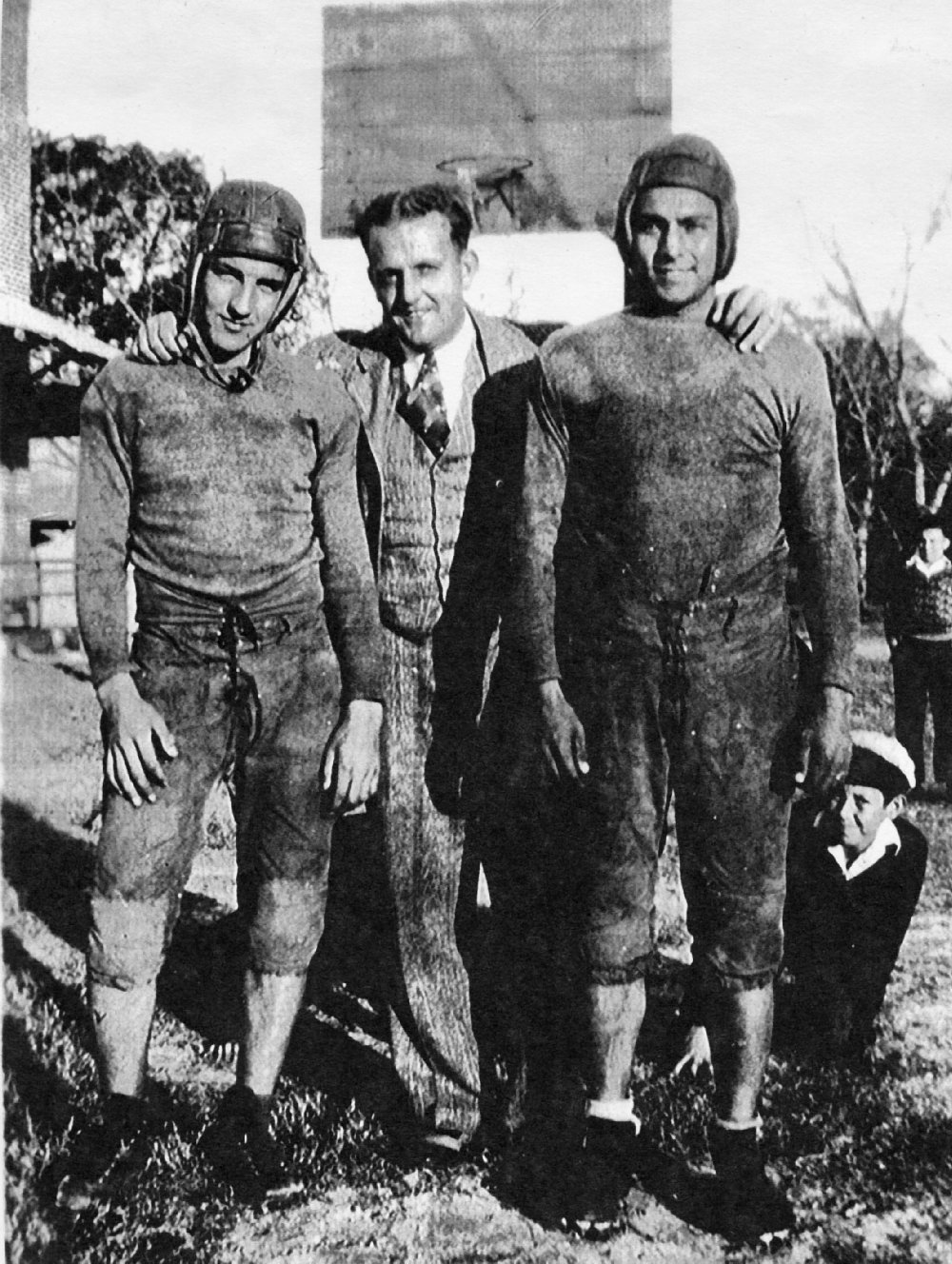
1930 OSHS Football Players
(l-r): Roy J. Riviere (1914-2000); Coach Gerald Hause; and Carl "Mexi" H. Dick (1909-2000).
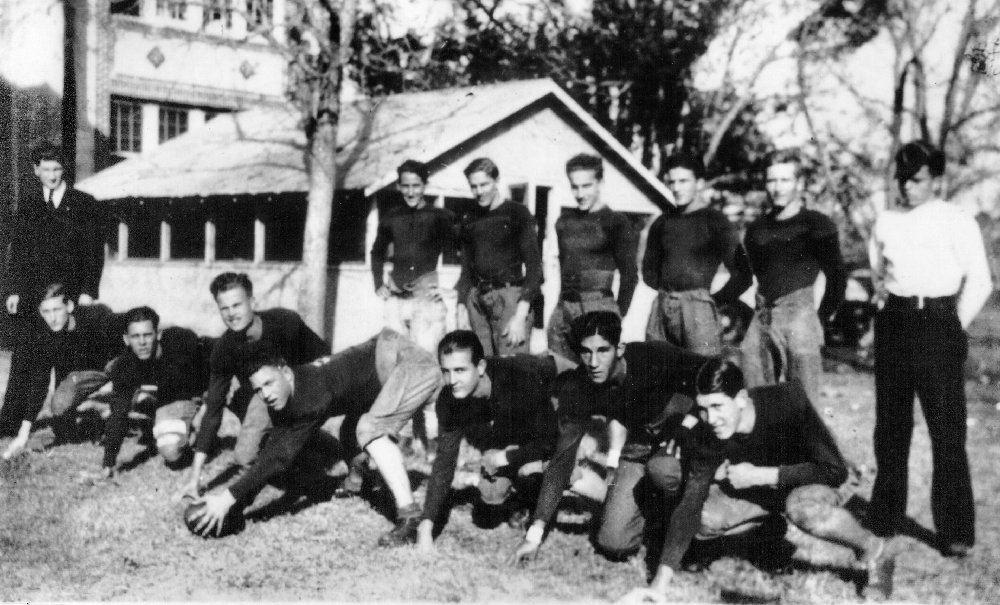
1933 OSHS Football Team
(standing: l-r: Coach LaCroix, Raymond Ryan (1914-1970); Edward J. Riviere (1916-1968); Roy J. Riviere (1914-2000); Everett Busbee (1912-1987); Frank "Cotton" M. Newcomb (1914-1964); and Beverly Dalgo (1917-2003), manager.
(in football stance: l-r: Tim Simpson (1918-1981); John Mitchell (1915-1963); ? Williams; Mike Mitchell (1918-2003); Alan Keebler; Henry Weyerstall (1913-1987); and Louis "Puckie" Mestier (1916-1994).
1947 Cheerleaders
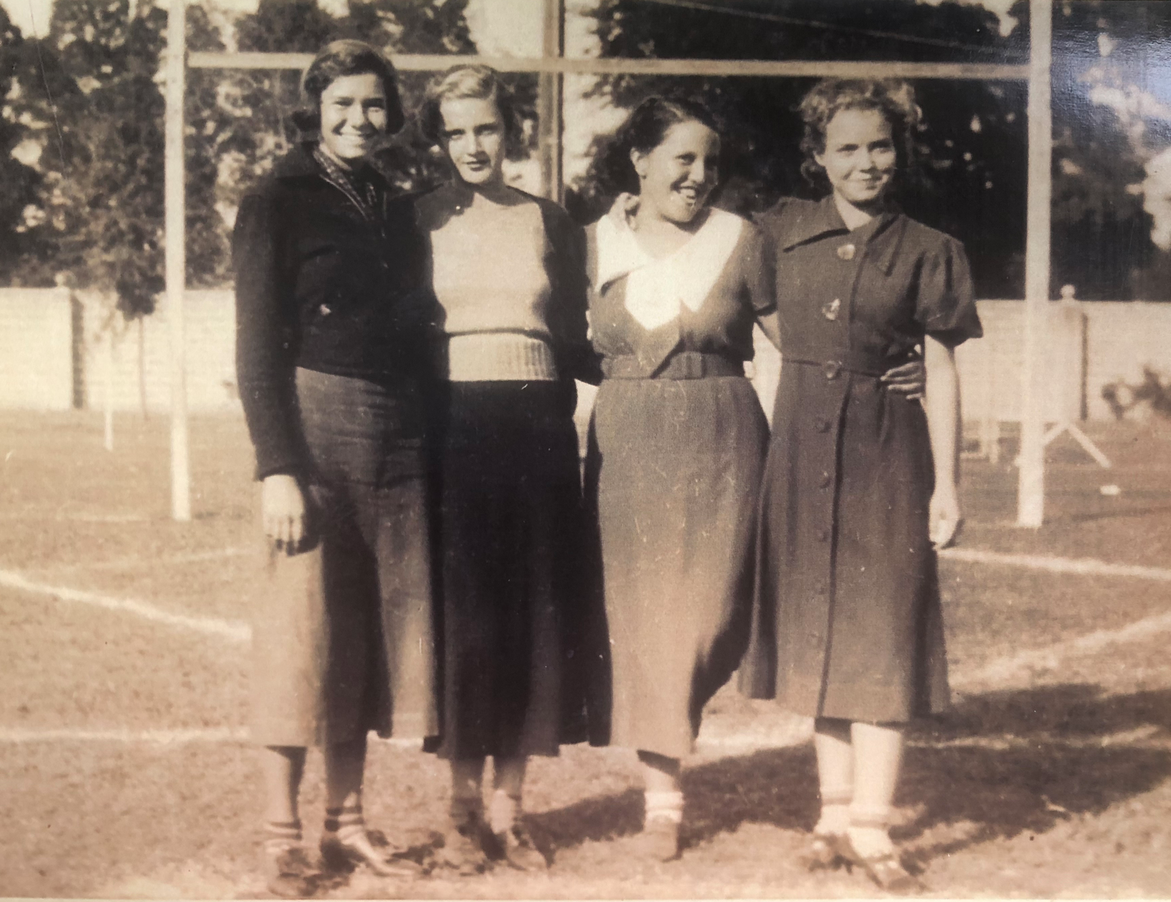
[L-R: Margaret Brou; Alice Davidson Hire; Eula Mae Ryan Zanca; and Thelma Dale]
1950 Football Team
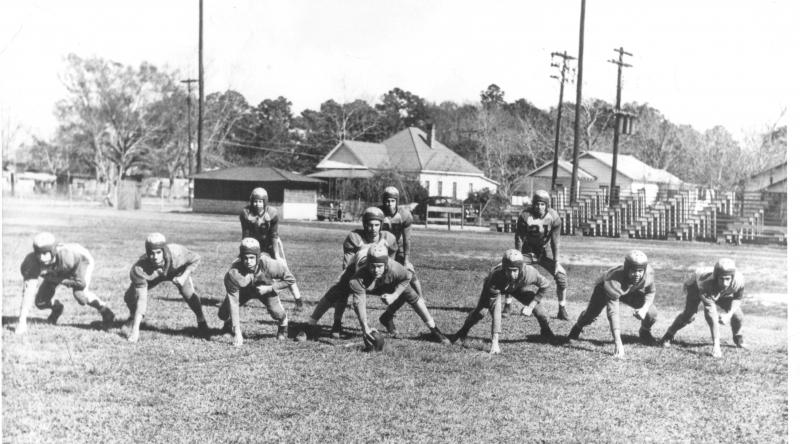
Swimming
Swimming ray Wed, 08/12/2020 - 16:10- 818 views
Lotty's Gallery
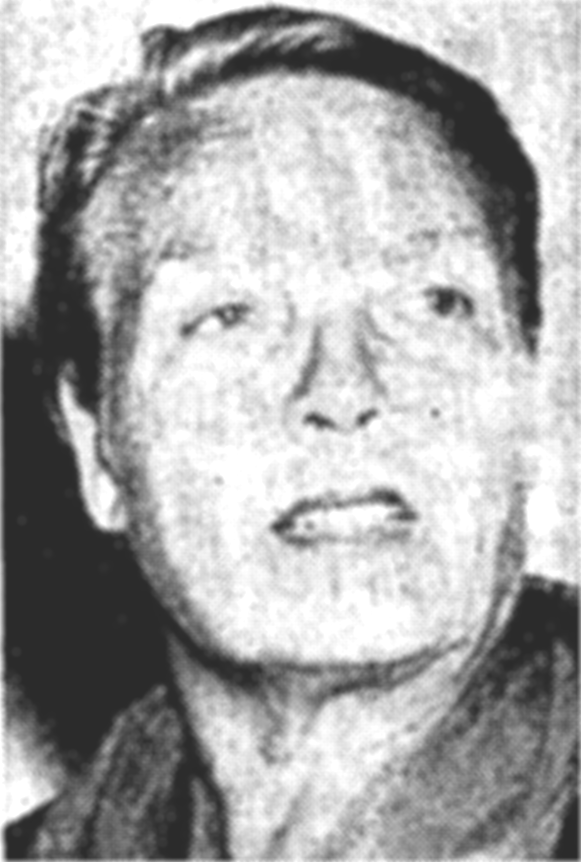
image made 1960
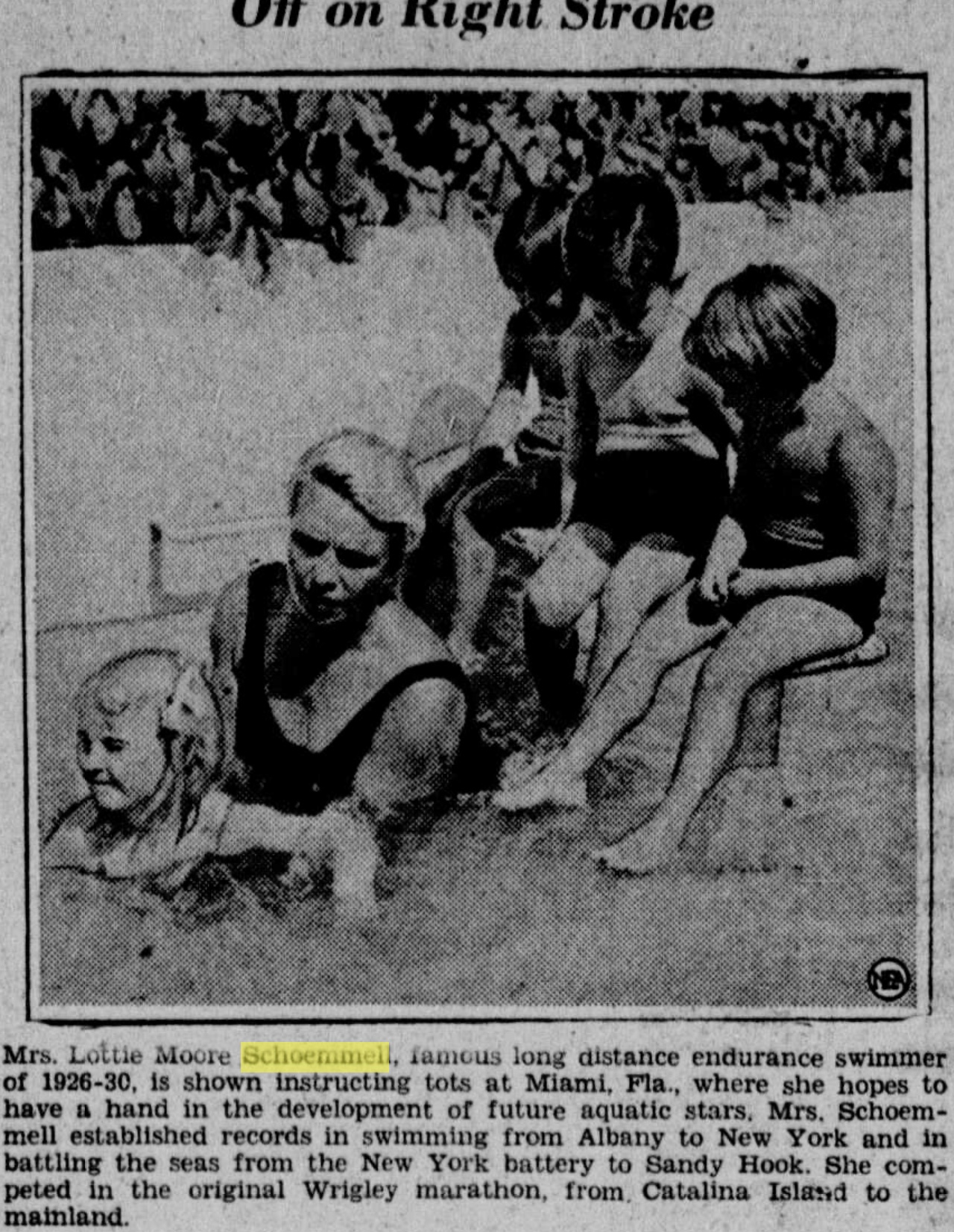
1935
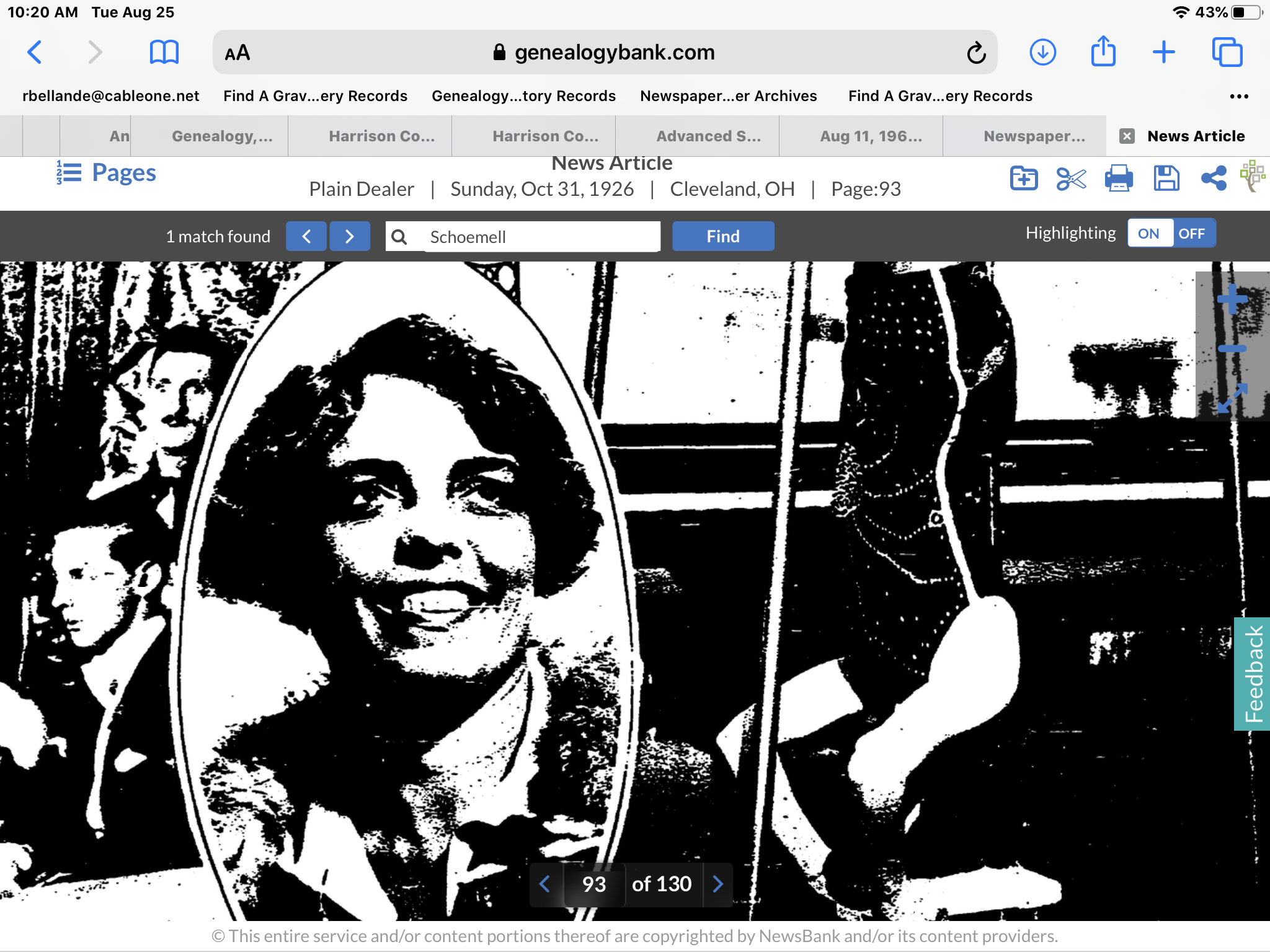
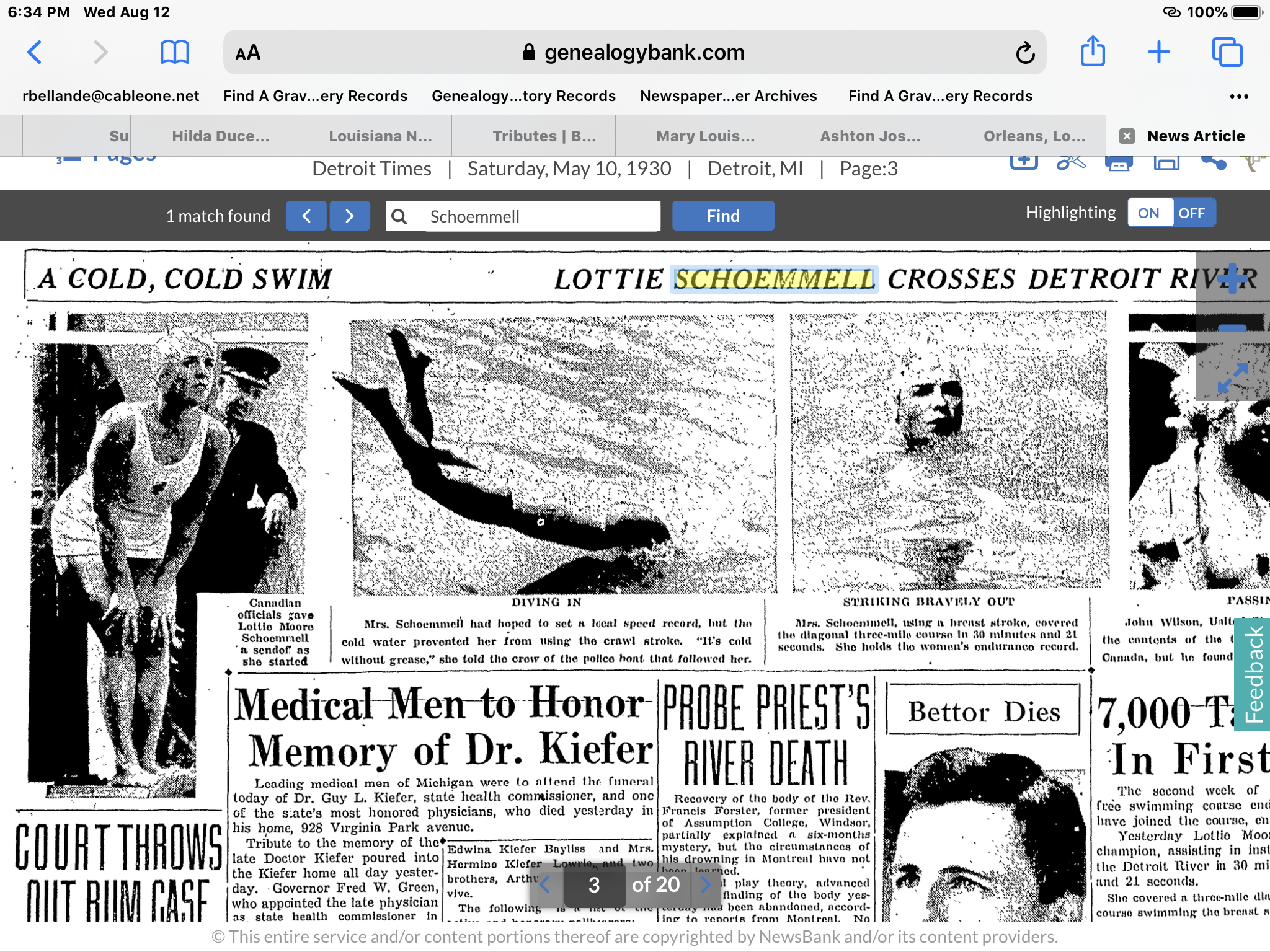
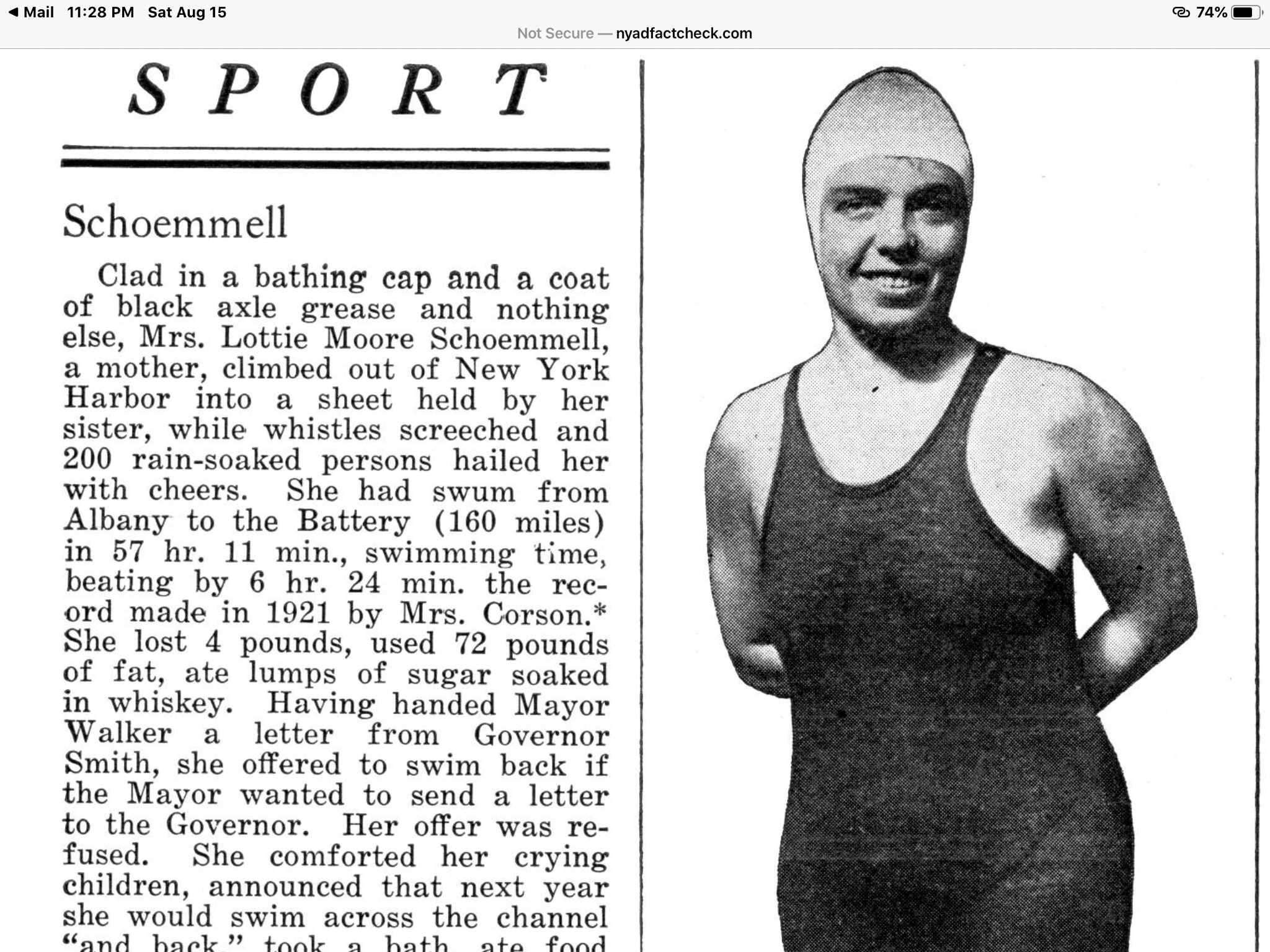
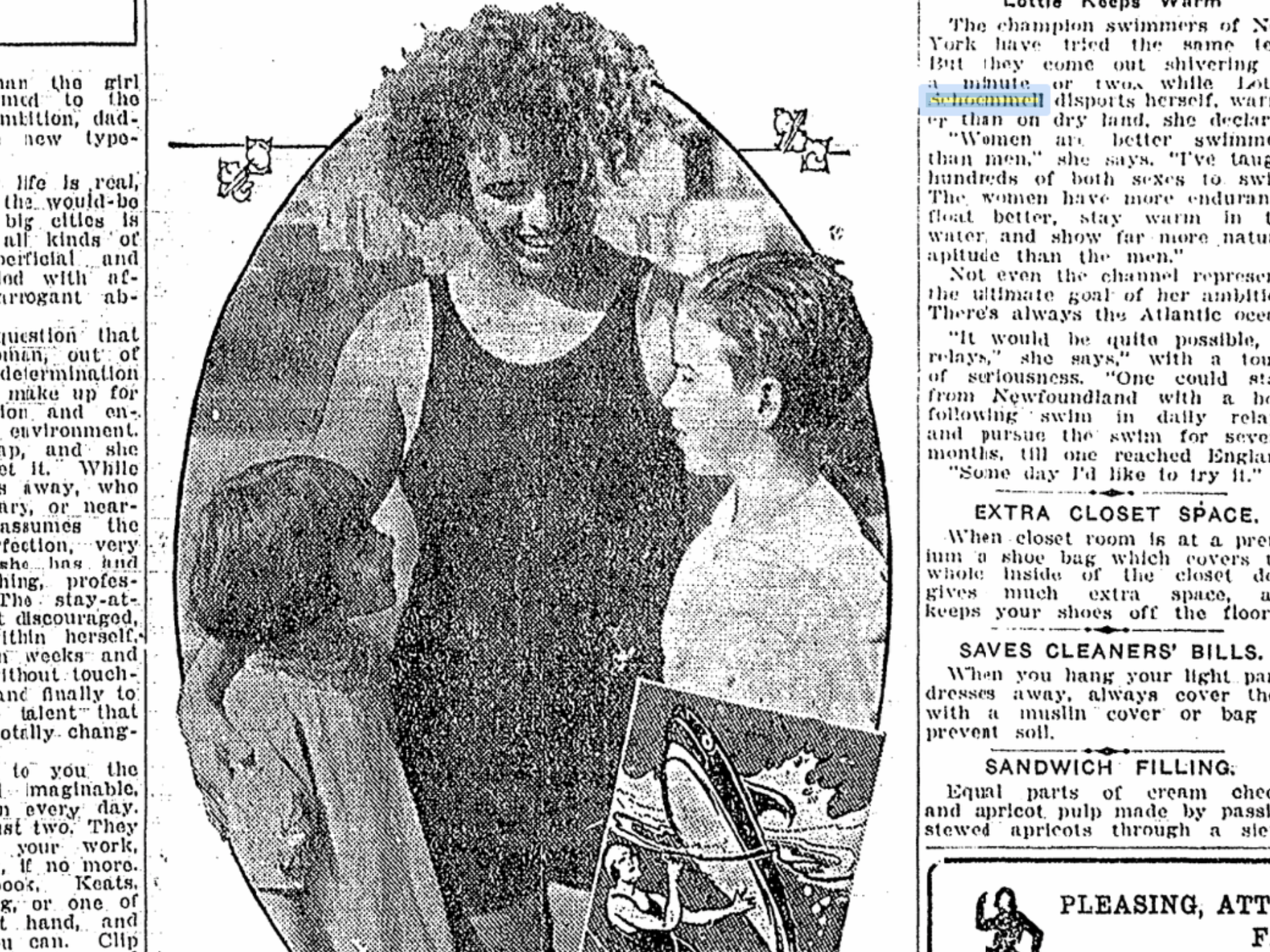
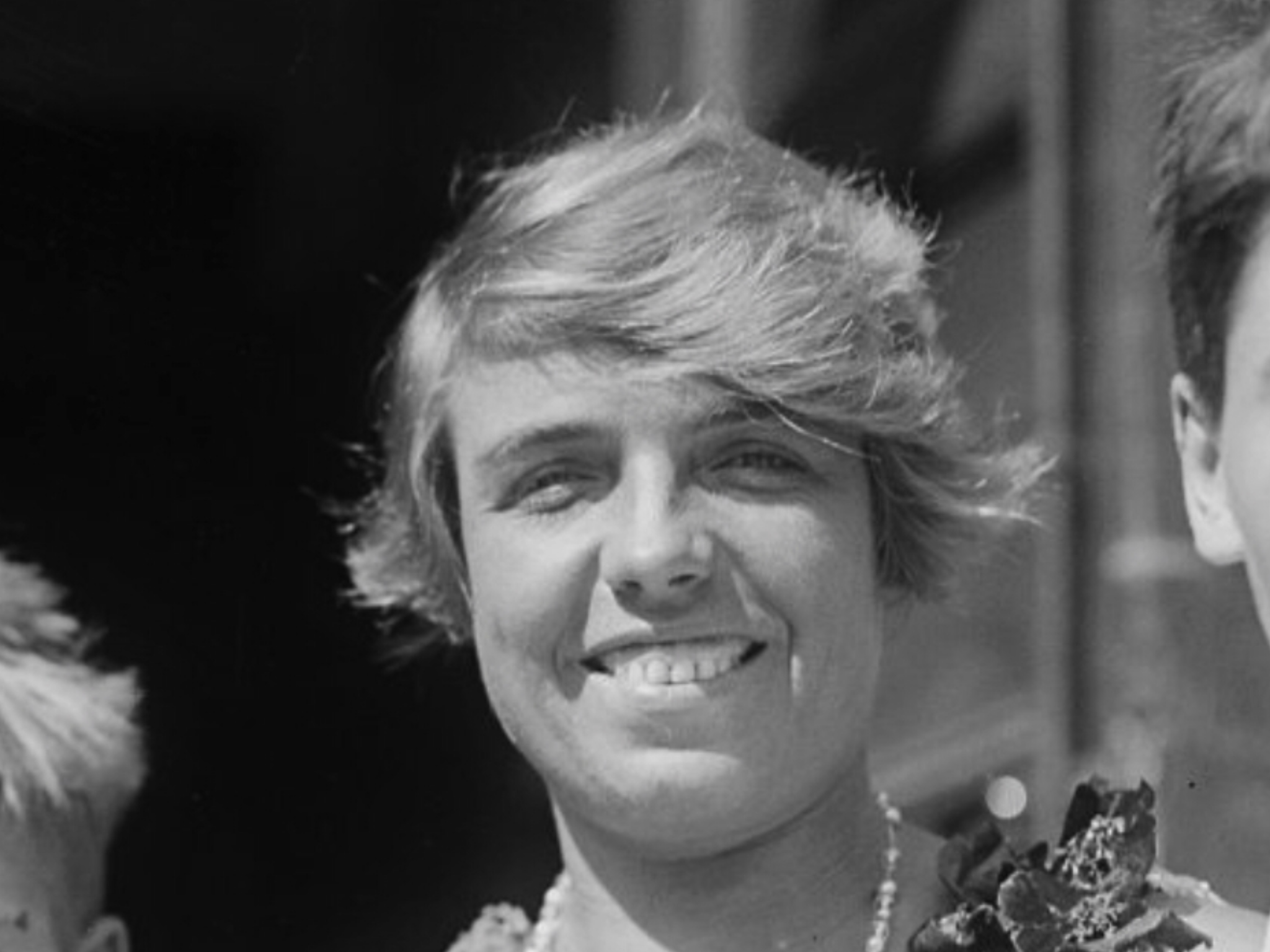
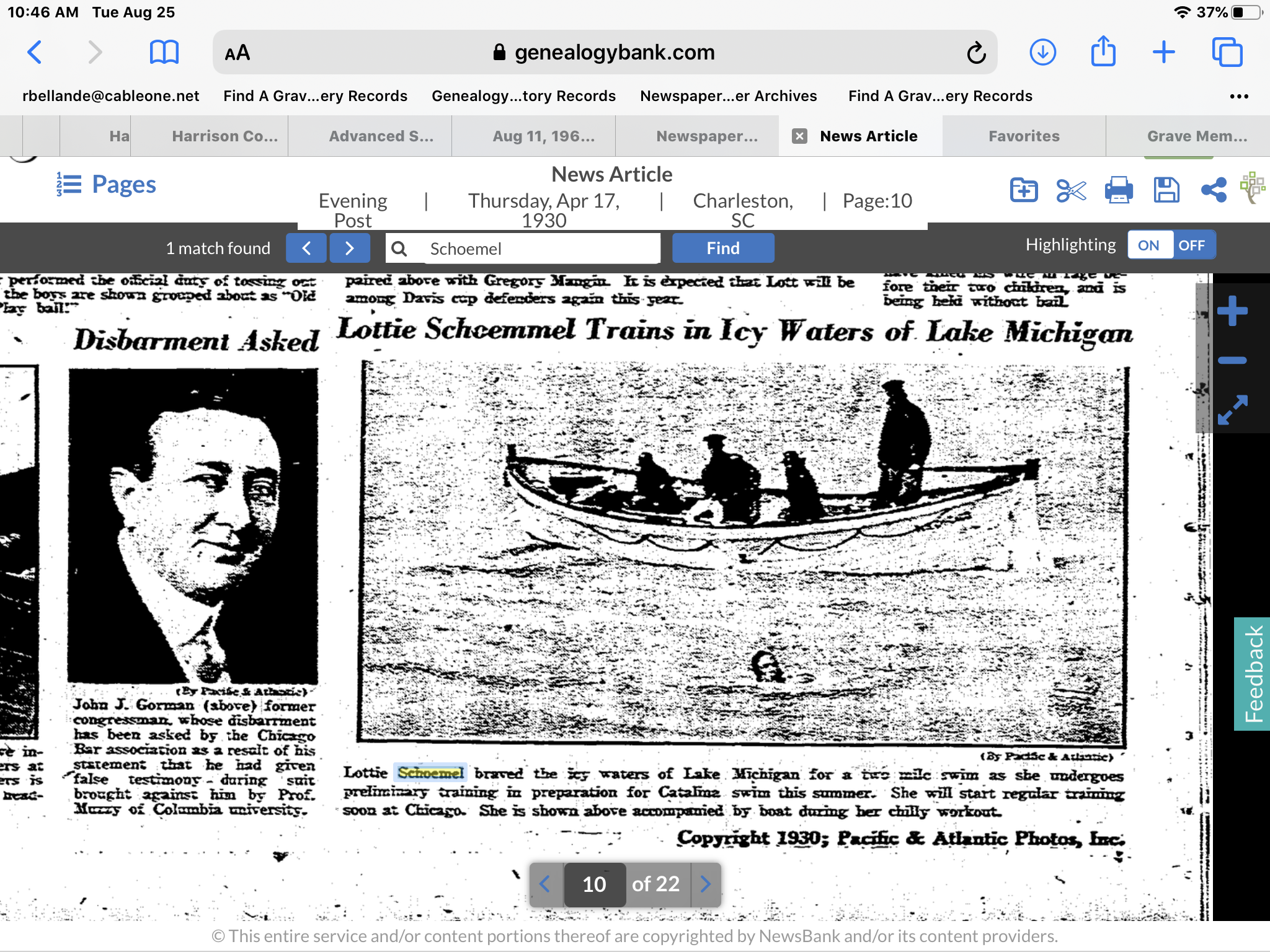
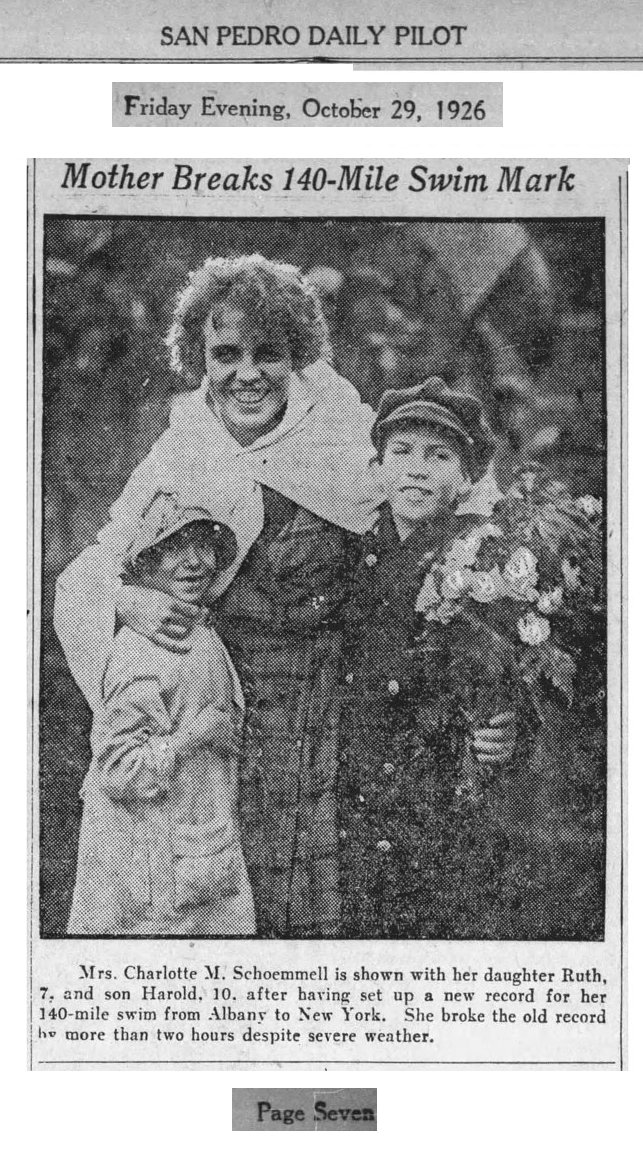
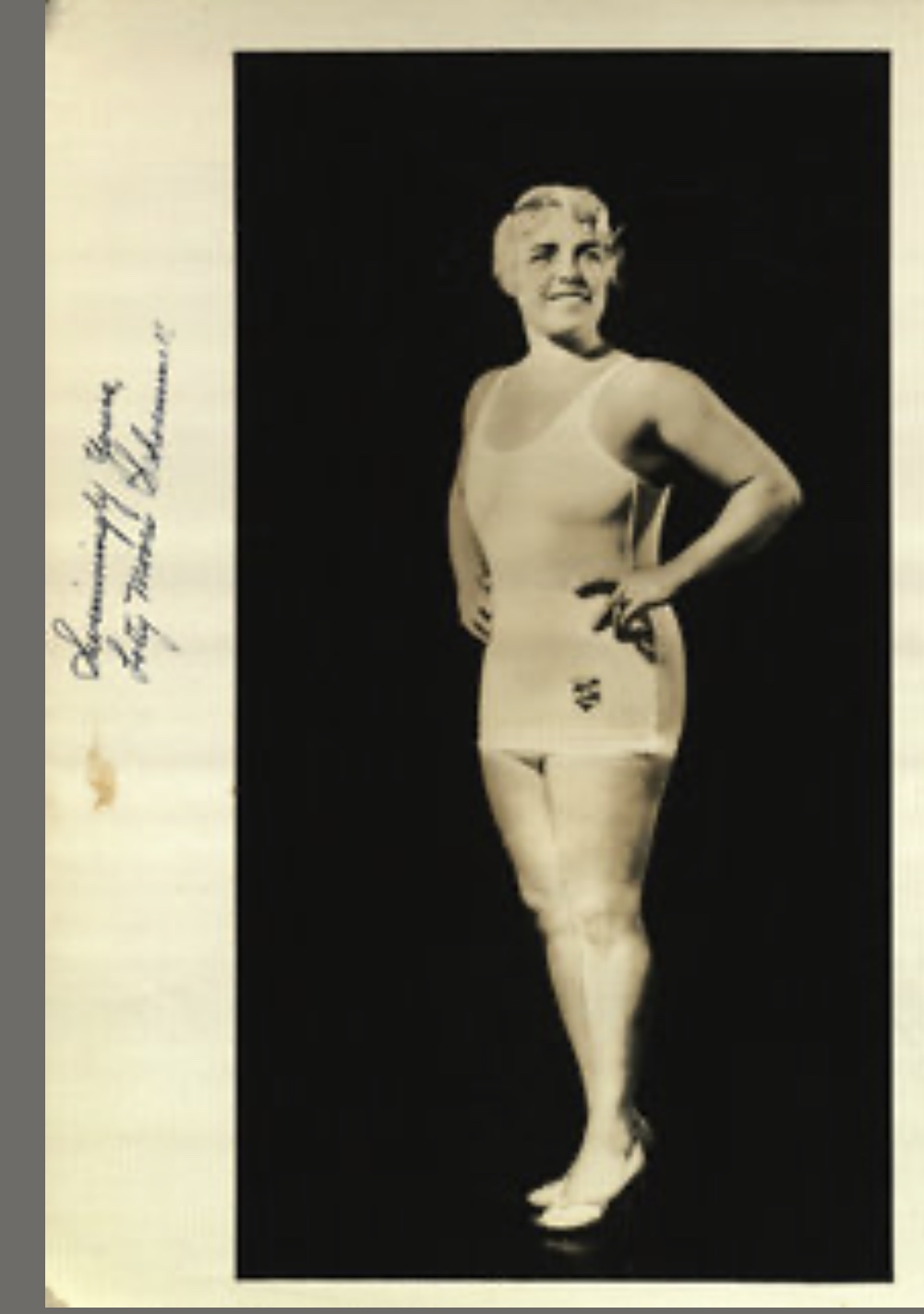

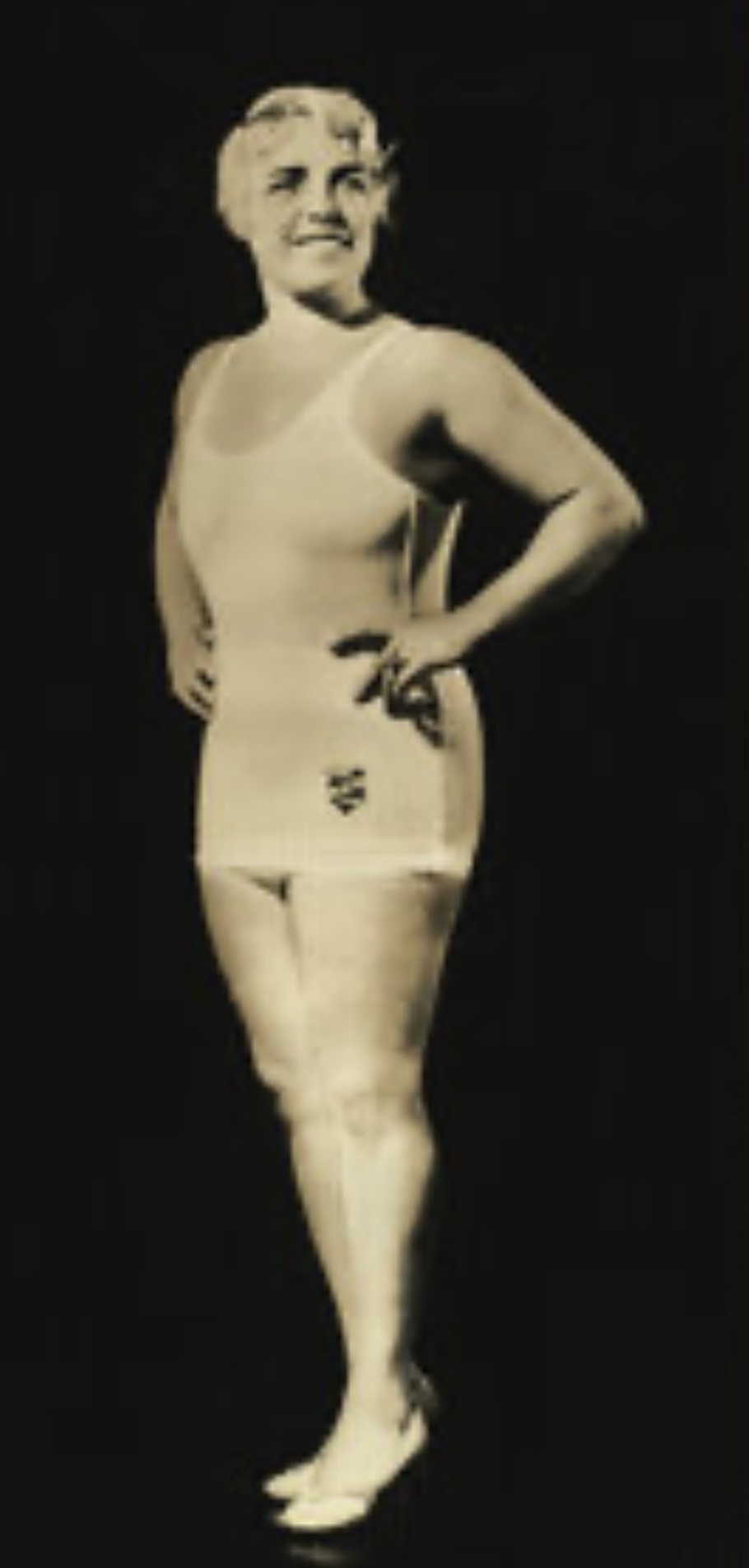
Recalling Lotty [1895-1966]
In the late 1940s, a middle-aged woman came to Ocean Springs, Mississippi from south Florida via the Bronx Borough of New York City. Her name was Charlotte Christina Moore Schoemmell. She had no connection with the E.R. Moore Company, a small, Chicago, based garment factory that operated on Government Street. Lotty, as she called herself, had been a world-class, long distance swimmer who set a plethora of swim records during her career in the icy waters of the Pacific Ocean and some northern bays, rivers and fresh water lakes. As we will discover Lotty was a unique individual and her character and spirit are indelibly stamped in the chronology of American and international swimming.
Ocean Springs has had good distance swimmers in the past. One of the first to make a claim in the Mississippi Sound was Hebert P. Beaugez Sr. [1895-1954] who as an amateur was awarded a medal in the 1927 Isle of Caprice Marathon swim race. Before his recent death, Herbert P. Beaugez Jr. was in possession of this relic.[The Daily Herald, August 24, p. 1, August 25, 1927, p. 1 and Herbert P. Beaugez Jr.-2017]
The Isle of Caprice Marathon sponsored by the Biloxi Chamber of Commerce was but one of many exciting venues that Biloxians were gifted in summers prior to Great Depression era. The Elks-PAT 4th of July celebration, Biloxi Yacht Club Regatta, greyhound races at the Biloxi Kennel Club all preceded the long distance swim to the Isle of Caprice. The first Elks-PAT [Elks Pull All Together] celebration was held on July 4, 1919. The event was a fundraiser for the Biloxi City Hospital Association and sponsored by the Biloxi Elks Lodge No. 606. Dr. Byron Holley was presented a check by the Biloxi Elks for $1600. (The Daily Herald, July 1, 1919, p. 1 and July 23, 1919, p. 1)
The Isle of Caprice was a low-lying sand bar just high enough to erect a resort for tourists. It rested about 14 miles southeast of Biloxi in the shallow waters of Dog Keys Pass between Horn Island and Ship Island. This bold endeavor was the creation of several Biloxi visionaries: W.H. ‘Skeet’ Hunt [1887-1960], Louis A. Caillavet III [1881-1946], Lewis E. Curtis Sr. [1888-1961] and John W. Apperson [1862-1939]. Judge J.O. Sanders [1874-1947] of Jackson, Mississippi was also a partner. On the eve of July 5, 1925, the Isle of Caprice resort opened for business. Fun seeking tourists departed for the resort from landings at the Biloxi Yacht Club, White House, Riviera Pavilion, and Wachenfeld’s Pier. The Silver Moon, commanded by Ed L. Moran (1888-1951), the brother of A.P. ‘Fred’ Moran (1897-1967) of Ocean Springs, Jolly Jack, Charles Redding, and Margaret provided transportation. In the new pavilion, music was made by the Buena Vista Orchestra.(The Daily Herald, July 6, 1925, p. 3)
The Isle of Caprice Marathon was held in August 1927, August 1928 and in June 1930. Swimmers from Memphis and Mobile dominated the race but some Biloxi locals like John Harkness, C.A. Young, Edward Thomas, Thomas Atkinson [1910-1974] and Charles Brumfield did reasonably well but never challenged the top competitors. Swimmers who completed the journey to the Isle had times that ranged between 6 and 7 hours. Since the event was sanctioned by the AAU there was no prize money awarded to the winner. First and second place finishers earned a loving cup and reimbursement for their four day hotel and transportation expenses to the event.[The Daily Herald, August 7, 1928, p. 1]
Brou Children
Another Ocean Springs family that distinguished itself in the water at this time was that of Edward Crawford Brou [1896-1949] and Bertridge “Bert” Bellman [1900-1990], the daughter of Philip M. Bellman [1872-1927] and Alice V. Seymour [1880-1957]. The Brou family came to Ocean Springs from NOLA circa 1910 when Marie Odette Brou (1879-1957) and spouse, Frank Bryan (1879-1936), built a fine Queen Anne cottage at present day 406 Jackson Avenue. The edifice was lost in Katrina [2005].(The Ocean Springs News, May 14, 1910 and JXCO, Ms. Land Deed Bk. 45, pp. 252-253)
Bert Bellman married Edward C. Brou in June 1920 and reared four children at Ocean Springs: Edward J. Brou (1921-2004), Margaret M. Brou (1922-2015), Philip E. Brou (1923-1958), and Claire E. Brou (1927-2017). Bert B. Brou in addition to caring for her family was involved in scouting and teaching swimming. While all of her children were excellent, competitive amateur swimmers, Edward J. Brou and Margaret M. Brou, went on to win local regional swimming championships.[JXCO, MS. Circuit Court MRB 13, p. 366]
In early September 1936, Edward J. Brou set a record at the Southern AAU swim meet in New Orleans, when he swam the mile in 25 minutes and 59 seconds while Philip Brou, his brother, placed sixth. Their sister, Margaret Brou, finished the two-mile race for women also in sixth place.[The Daily Herald, September 3, 1936, p. 5]
A week later when Governor Hugh Lawson White [1881-1965] of Mississippi and Governor Richard W. Leche [1898-1965] of Louisiana were in Biloxi to compete in a sailboat race, a series of swim races were held in the Biloxi Channel. Here Ed Brou again demonstrated his dominance over Biloxi swimmers by winning the mile race and 100-yard dash for juniors. Margaret Brou also won her races.[The Daily Herald, September 7, 1936, p. 2]
At Baton Rouge in August 1939, Margaret M. Brou was the Southern AAU junior relay champion. (The Jackson County Times, August 12, 1939]
In recent years, Claire E. Brou, a retired Navy-Air Force veteran, has distinguished herself in the National Veterans Wheelchair games. In 1997, she won five gold medals in San Diego at the Veterans’ games for her skill in air rifle shooting, bowling, swimming, table tennis, and motorized wheel chair rallying. (The Sun Herald, July 18, 1997, p. D-1)
Other Coast swimmers of note at this time were Louis Mestier, Rene Trochesett, and George Budinich,
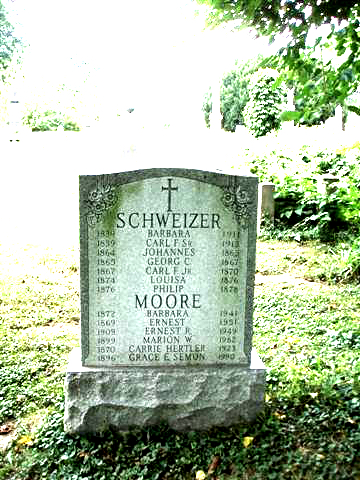
Lotty
Charlotte ‘Lotty’ Christina Moore was born in the Bronx on February 13, 1895, the eldest child of Ernest Joseph Moore [1869-1951] and Barbara Schweizer [1872-1941]. Her siblings were: Grace Edna Moore [1896-1990] m. Daniel Henry Schwarz and Mr. Semon; Marion Moore [1898-1952]; Gladys Moore Burchetta [1901-1994]; Ethel Rose Moore [1906-1983]; and Dr. Ernest Richard Moore [1909-1949] m. Margaret V. Sampson.
Ernest J. Moore was born in England and had come to America in 1891 to work in the booming Bronx piano manufacturing industry. He married Miss Schweizer in April 1894 in New York. In the Bronx, the Moore children were baptized in the Episcopalian faith although their mother was a founder in 1922 of the St. Barnabas Lutheran Church at Howard Beach in Queens, New York.[The Daily Herald, September 18, 1952]
In mid-June 1904, The General Slocum, a large excursion boat with about 1400 passengers and crew, had set sail for a day trip to Locust Point in the Bronx on the Long Island Sound. While motoring down the East River the large wooden vessel caught fire and was beached on a small island in the East River. This tragic event, which occurred with the loss of over 1000 lives, mostly women and children of the St. Marks German Lutheran Church, was witnessed by Lotty, then a 9 nine-year old girl while father in a skiff was attempting to rescue the victims of this riverine conflagration. From this traumatizing experience, Lotty Moore learned to swim and swim she did indeed![The New York Times, June 16, 1904, p. 1 and The Daily Herald, December 27, 1959]
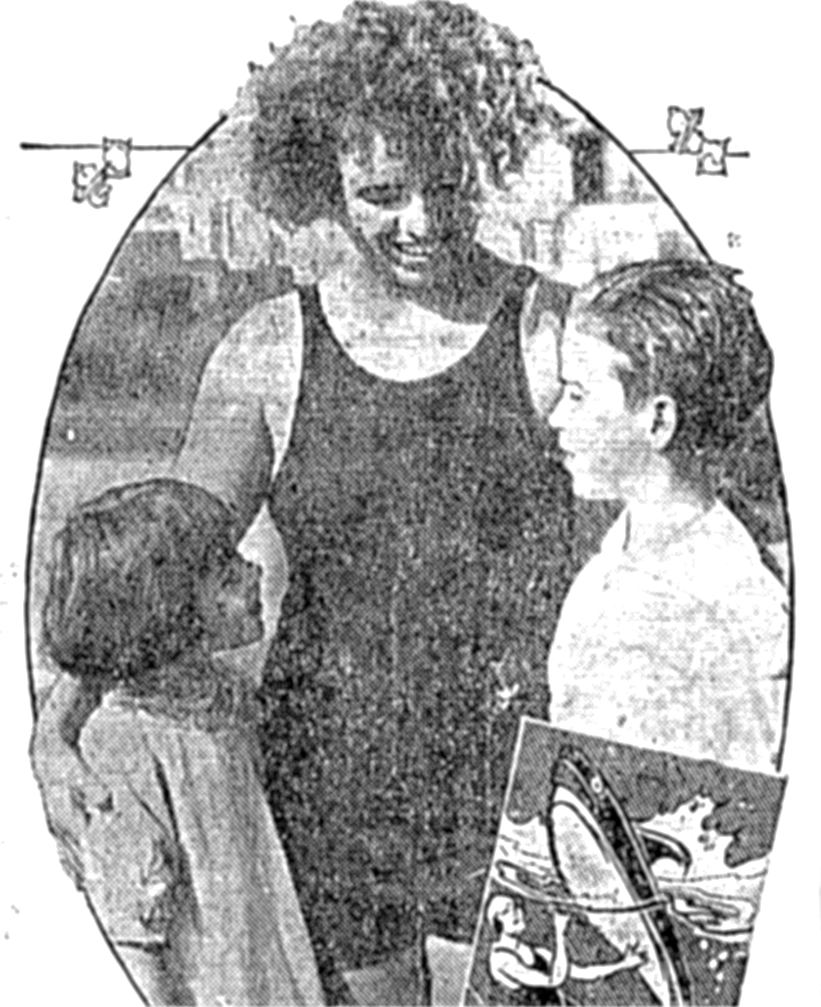
This 1926 vintage image of Lottie Moore Schoemmell [1895-1966] depicts her in he most familiar dress, a swimsuit, unless she were endurance swimming, with her children, Ruth Grace Schoemmell [1919-1988] and Harold LeRoy Schoemmell [1916-1989]. Lotty was a working mother rearing two children in the Bronx while competing against world class women several who had successfully swam the English Channel. Lotty spent her last 19 years in Ocean Springs teaching children to swim and operating a precursor of today’s health and wellness centers.
Fortunately, Lotty Moore Schoemmell [1895-1966], a 5 foot 2 inch, 146 pounds of curly, blonde energy, was in the prime of her physical being during one of America’s great fad eras, the decade after World War I and during the Great Depression. It was during a period in American chronology when open sea and pool marathon swimming was at its zenith, especially for women. During this time the English Channel, the Catalina Channel [California] and the circumnavigation of the Isle of Manhattan [NYC] were salient venues for icy water marathoners. These events became known as “The Triple Crown of Open Water Swimming”. Outstanding American women to excel during these twenty odd years were: Gertrude Ederle [1905-2003], Mille Gade Corson [1897-1982], Myrtle Eaton Huddleston [1895-1937], and our own Lotty Moore Schoemmell.[J.J. George, Sports History Review, Vol. 26-January 1995 and The Kingston [New York] Daily Freeman, October 14, 1926, p. 13]
Bronx-Queens
In October 1914 in the Bronx, Lotty Moore, now nineteen years old married, Martin Schoemmell [1881-1963], fourteen years her senior. Martin made his livelihood as a chauffeur and taxi driver in the NYC area. The Schoemmell’s first childen were: Martin W. Schoemmell [1915-1915]; Harold LeRoy Schoemmell [1916-1989] m. Mary Agnes Veverka [1918-2004], was born in October 1916; and Ruth Grace Schoemmell [1919-1988] came into the world in May 1919.
Martin Schoemmell Jr.
Martin Schoemmell Jr. [1881-1963] was born September 2, 1881 in the Bronx County, New York to Martin Schoemmell Sr. [1834-1906], a native of Hostorf, Bavaria, Germany and Magdelena “Lena” Brixner [1846-1902], a native of New York.
Martin Schoemmell Sr. expired at Bronx County, New York on October 25, 1906 at Unionport, Bronx County, New York. Lena Schoemmel had preceded him in death passing on September 25, 1902, also in Bronx County, New York. Martin Schoemmell Sr. legated to Martin Schoemmell Jr. $2000 his wardrobe and jewelry. Martin and Emma Schoemmell, his sister, were also left to share equally the remainder of their father’s real estate and personal property after his other bequeaths had been legally executed.[Bronx County, New York Will Book 801-802, p. 359]
Martin Schoemmell Jr. married Mary F. Murray in Bronx County, New York on February 28, 1934. She filed for divorce in Bronx County, New York.[see Bronx County, New York Civil Case No. 1706, Bk. 2, p. 353]
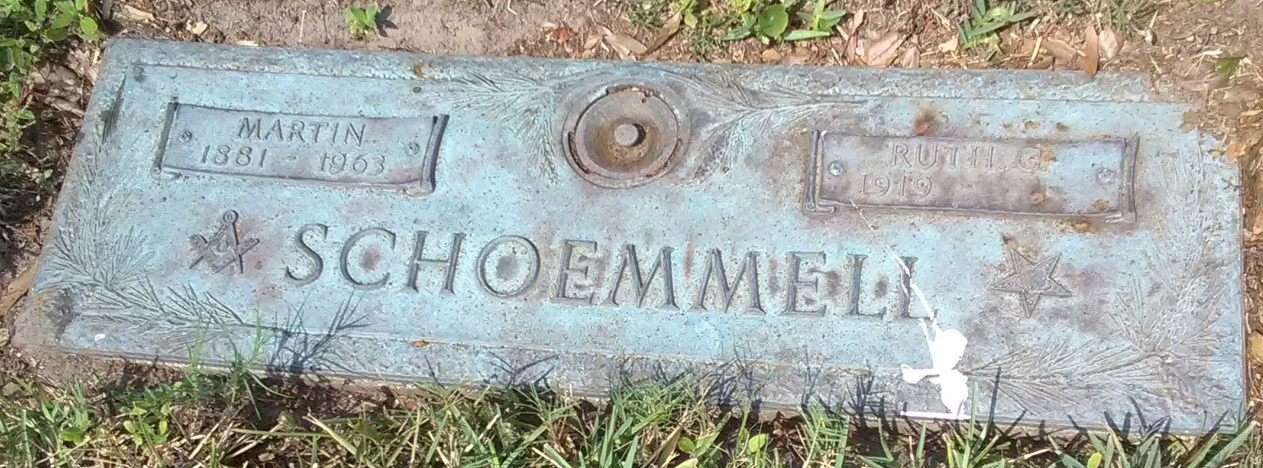
Martin Schoemmell Jr. expired at Gulfport, Florida on August 7, 1963. His corporal remains were interred in the Memorial Park Cemetery [Memorial Gardens] at St. Petersburg, Florida.
Before the swimmer
Before she became a professional swimmer, swim coach and NYC public school swim instructor, Mrs. Schoemmell had an olio of odd jobs in her native Bronx and at Howard Beach on Jamaica Bay in Queens. She could claim to have been a telephone operator, carpenter, and seamstress. Lotty also had some Red Cross nurse training but soon found herself as New York’s only woman lifeguard at Howard Beach where she made many successful rescues of beleaguered swimmers.[The Santa Ana [California] Daily Register, December 2, 1926, p. 18]
Grease Suit
Lotty Moore Schoemmell was an innovator in the world of endurance swimming and is credited with the invention of the “grease suit”. The “grease suit” consisted of about 10 pounds of black, axle grease that was layered up to about one-inch on the skin of the nude or au naturel body. This lubricant acted as an insulator from the very cold waters that generally were de rigueur for long distance racers. The lack of a swimsuit also meant less confinement and motion restriction. The suit also lacked efficient insulating properties. In addition, some swimmers believed that sharks were not attracted to dark objects [fur seals not excluded?] in the water, but the pungent grease odor was probably a more effective deterrent to their attraction and attack. Mrs. Schoemmell may have not worn a bathing suit but she was never without a sharp dagger in case a shark came into her arena.
The salient endurance and celebrated record swims of Lotty Moore Schoemmell are as follows:
1926
New York Bay
In July 1926, Lotty broke the June 1925 record set by Gertrude Ederle when she swam from Battery Park to Sandy Hook, New Jersey across tide swept New York Bay. At this time Miss Ederle was practicing for her first attempt at “the Big Ditch”, the English Channel, also known as the Straits of Dover. Mrs. Schoemmell’s elapsed time for the almost 17 mile swim was 5 hours and 57 minutes. Miss Ederle who in August 1926, would be the first woman to swim the English Channel made the New York Bay crossing in 7 hours and 21 minutes.[The Post-Herald [Beckley, West Virginia], June 16, 1925 and [http://longswims.com]
Manhattan Island
On 19 September 1926, Mrs. Schoemmell completed the circumnavigation of the Island of Manhattan. This 40-mile swim was completed in 14 hours and 21 minutes and elapsed the record of Mille Gade Courson by 36 minutes.
[http://longswims.com]
Hudson River
In October 1926, Lotty completed a 160-mile swim in the Hudson River from Albany, New York to Battery Park on the southern tip of Manhattan breaking the record of Amelia ‘Mille’ Gade Corson [1897-1982], second woman to swim the English Channel. The aquatic journey of about ten days by Mrs. Schoemmell took 57 hours and 11 minutes in 59F water.[The Times-Picayune, October 21, 1926, p. 13]
Boston Harbor
The water temperature was 39F. The air temperature was 42F. Throw in a breezy wind creating choppy waves and voila, a perfect Boston day to take a swim? Not really, but three young women left Charlestown, Massachusetts on the morning of 21 November in these adverse conditions to swim across Boston Harbor. Lotty Moore Schoemmell, Eva Morrison and Mae Elwell, both from Revere, Massachusetts, never completed their objective, but Lotty could claim a ‘morale win’ in that she remained in the water for 2 hours and 20 minutes some 13 minutes longer than Miss Morrison. Miss Elwell quit the ordeal after 56 minutes![The Boston Herald, November 22, 1926, p. 1]
Delaware River
Another ‘stunt’ swim performed by Mrs. Schoemmell occurred in the Delaware River on 29 December 1926. The event was rather brief as it took only 10 1/2 minutes in the icy river to reach the New Jersey shore. This occasion was to commemorate the 1776 Christmas night crossing by George Washington leading his ragtag Continental Army to fight Hessian troops at Trenton, New Jersey.[The Gulf Coast Times, September 18, 1952, p. 1]
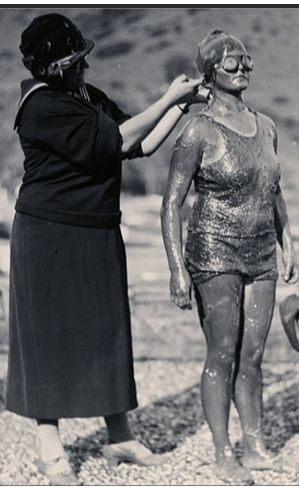
It was January 1927 and Lotty Moore Schoemmell [1895-1966] was one of thirteen women competing in the Wrigley Marathon swim for the $15,ooo first prize if a woman was the first to reach San Pedro by crossing the 22 mile Catalina Channel that separated Santa Catalina Island from Los Angeles. Lotty who spent her final 19 years in Ocean Springs didn’t win that day, but she created some ink with her non-bathing suit. Mrs. Schoemmell was the first to swim au naturel using black, axle grease as an insulator to protect her body core temperature in very frigid waters. She also carried a large knife in case a shark or other marine predator threatened. The suited lady in this image is unequivocally not Lotty, as she prepares to enter the icy Catalina Channel.
1927
Catalina Channel-California
In mid-January 1927, William Wrigley Jr. [1861-1932], Chicago chewing gum, manufacturing magnate, sponsored a $40,000 Catalina Channel Marathon. The race began at Avalon on Santa Catalina Island and finished at Pedro Point [now Point Fermin], near Long Beach, California, a swimmer’s distance depending on the tides and currents of 21-30 miles in a cold Pacific Ocean. First prize for a male swimmer was $25000 and first woman to finish received $15,000. If a woman won the race, she got $25,000 and there was no second place! Lotty was nine miles from shore when her leg became paralyzed from muscle cramping and shear exhaustion and also the numbing effects of the cold water.[The Lincoln Sunday Star January 16, 1927, pp. 1-2 and The Winona Republican-Herald, January 13, 1927, p. 4]
The Catalina Channel race rules committee had approved her ‘bathing suit’, which consisted of 10 pounds of black axle grease. Mrs. Schoemell reasoned that swimming sans bathing suit would be less restricting and give her some protection against shark attack since she believed that they rarely attacked dark, shadowy objects in the water. Fur seals would vehemently disagree with this claim if they could talk! Mille Corson, her chief rival, had threatened to withdraw from the contest if Lottie ‘wore’ her grease suit![The Times-Picayune, December 3, 1926, p. 21]
Catalina Channel-2
In early February 1927, less than a month following the Wrigley sponsored Catalina Channel Marathon, four swimmers, Lotty Schoemmell, Martha Stager, Myrtle Eaton Huddleston [1895-1937] and Peter Meyers, set out from Santa Catalina Island for the mainland. Myrtle E. Huddleston was the only swimmer to complete the race and became the first woman to conquer the San Pedro or Catalina Channel as it is popularly called. Mrs. Huddleston was attacked by barracuda during the challenge which ended with her being was semi-paralyzed and what seemed to be a semi-comatose state. Lotty was able to swim only six of the 20 odd miles to the Port of Los Angeles. [The Reno Evening Gazette, February 7, 1927, pp. 1-3]
Golden Gate
Seemly, Lotty Moore Schoemmell was very enamored with California. After her second failure of the Catalina Channel, she went north to San Francisco to challenge the Golden Gate, another cold, tide and current swept venue. Before the attempt, Lotty predicted that she would free style across the Golden Gate and return with her hands tied behind her back! Foot in mouth, Mrs. Schoemmell pulled herself into the escorting boat after completing only the first leg of her planned swim.[The Santa Ana [California] Daily Register, May 5, 1927, Section III, p. 1 and The San Francisco Chronicle, July 14, 1928]
Catalina Channel-3
In early May, Lotty M. Schoemmell appears to be a resident of Long Beach as she entered the Long Beach-Catalina Island Rowboat Marathon set for 12 June.[The Santa Ana [California] Daily Register, May 5, 1927, Section III, p. 1]
In mid-April, Lotty had competed in the Venice-Los Angeles 17 mile dance marathon and finished among the final competitors. L.E. Rand, Long Beach, dance master, and Lotty completed at least 20 hours of dancing, although they did not win the $1000 first prize. [The Brainerd [Minnesota] Daily Dispatch, April 22,1927, p. 8]
Lake George-New York
The $3000, 24-mile, Lake George American Legion Marathon began in mid-July at Hague, Warren County, New York with 101 competitors and ended at Fort William Henry with only four swimmers in the clear lake waters. The long distance competition was completed by Edward F. Keating of New York in 18 hours and 25 minutes. Lotty Moore Schoemmell, then a resident of Howard Beach, Long Island, New York, was in third place when Keating finished and just behind Lucy Diamond of Brooklyn.[The Indianapolis Times, July 13, 1927, p. 13]
With her boundless energy, Mrs. Schoemmell appears to have remained in the Lake George region to train for a marathon swim in Canada. Here in August, she rowed a boat the length of Lake George, 32 miles, in eight hours.[The Trenton [New Jersey] Evening Times, August 20, 1927]
Toronto
In late August 1927, Lotty M. Schoemmell with about 300 other aquatic competitors entered the $50,000, 21 mile, Lake Ontario Marathon at Toronto, Canada with a 54F water temperature. Although no woman completed the race, Lotty was awarded $3500 for swimming about 11 hours and being the last female to leave the water. She outlasted such lauded paddlers as: Ethel Hertle, Clarabelle Barrett and Jane Sion. Only three men completed the marathon. [The Sandusky Star-Journal, August 31, 1927, p. 7; The Havre Daily News-Promoter [Montana], August 31, 1927, p. 1; The Syracuse Herald, September 1, 1927, p. 20; and The Cincinnati Commercial Tribune, September 2, 1927, p. 7]
1928
On the last day of March 1928, at Miami Beach, Mrs. Schoemmell set a new world endurance swim record that had been recorded at Blackpool, England by Edith Johnson in 1880. She swam in a pool at the Deauville Casino for 32 hours.[The Detroit Times, April 2, 1928]
In early April 1928, Lotty Moore Schoemmell sent a challenge to Mercedes Gleitze, a London typist, who recently had swam the Strait of Gibraltar. Lotty wrote: “Congratulations. I challenge you to race across the English Channel in September. Invite Miss Gertrude Ederle, Mrs. Mille Gade Corson, and Miss Barrett. Regards.” Mercedes declined the offer by relating to Lotty that she was not a racer, but an endurance swimmer.[The Sioux City [Iowa] Journal, April 10, 1928, p. 12]
In October 1928, Mrs. Schommell swam with her hands and feet bound from Statue of Liberty to Battery Park, a distance of 2 miles. Obviously, this was a ploy to keep her name in the ink game.[The Winona [Minnesota] Republican Herald, October 18, 1928, p. 8]
1929
Tidal Basin
Returning to New York in early May, Lotty M. Schoemmell sought permission to swim around the Tidal Basin, an artificial lake, on the Potomac River in Washington D.C. Lt. Colonel U.S. Grant [1881-1968] III, grandson of General U.S. Grant [1822-1885], was the director of the Office of Public Buildings and Public Parks. Deemed a publicity stunt as Lotty had proposed to circumnavigate the 107-acre ‘pond’ with hands and feet tied, her request was denied.[The Evening Star [Washington DC], May 4 1929 p. 2]
North River
Another “media” swim for Lotty M. Schoemmell was performed in October 1929, when she with her father rowing the escort boat, went in the North River at 79th Street and in 2 hours 5 minutes emerged at Battery Park at the tip of Manhattan.[The Richmond Times Dispatch, October 21, 1929, p. 12]
During the performance, Mrs. Schoemmell was shackled in the handcuffs used by Gerald Chartres [1887-1926] alias Gerald Chapman, a hardened criminal, much celebrated for his crimes and the precursor of the later lauded sociopaths, John Dillinger [1903-1934] and Alphonse G. Capone [1899-1947]. Chapman was hanged in Connecticut in April 1926 for murdering a policeman during a bank robbery.
[https://www.newenglandhistoricalsociety.com/gerald-chapman-gentleman-bandit-phony-british-accent/]
1930
B.V.D.
In 1930, Lotty received a sponsorship from the B.V.D., the underwear company, to promote their swimsuits. The iconic brand was founded in 1876 and named after the three founders of the New York City firm Bradley, Voorhees & Day, "B.V.D." The term came to be used, however incorrectly, for any underwear in the style popularized by BVD. Berkshire Hathaway is the current owner.
Mrs. Schoemmell would visit cities and inquire of the most challenging swim in the area. She would usually swim a river or lake and set a record because no one with her reputation had ever attempted it before. In this way she acquired many national records and a paycheck along the way. Lotty’s national publicity was growing with these mundane conquests.[The Berkeley Daily Gazette, June 20, 1930, p. 15]
Health and Nutrition Advocate
Appearing as a representative of The B.V.D. Swim Club, Lotty made an appearance at Chicago in mid-April to lecture to women interested in her views on “Diet…Exercise…Weight Control”. She had three afternoon sessions on successive days in the dining room of the Davis Company.[The Chicago Daily Times, April 16, 1930, p. 4]
Aids the Poor
Lotty having to work and raise her two children could appreciate the efforts of those less fortunate. An example of her charitable heart occurred in April 1930 when she donated $5 to the Easter Shore Fund organized by a leading Chicago journal. In the letter was this missive: “I have tasted the cup of poverty so, [I] realize what it mean to be without shoes. Enclosed you will find check for $5 for The Daily Times Easter Shoe Fund. Wish I could make it $500, but every bit helps. May these kids use the shoes in health. Swimmingly yours, Lotty Moore Schoemmell.[The Chicago Daily Times, April 11, 1930, p. 16]
Detroit
In early May, while representing the B.V.D. Swim Club, Lottie was at Detroit for about two weeks lecturing and demonstrating how she achieved international success as a distance swimmer. Over 7000 youngsters participated in the Detroit Times-Recreation Department free, 6-week swimming classes. About 3000 of the students were females.[The Detroit Evening Times, ‘Endurance champion aid swim classes’, May 6, 1930, p. 20 and May 10, 1930, p. 3]
Detroit River
On May 9, 1930, swam a 3-mile, diagonal course in the Detroit River, which began in Canada and finished in Michigan. Using the breaststroke, her elapsed time was 30 minutes and 20 seconds. Although the water temperature was 52F, Lotty swam in a bathing suit rather than her usual ‘grease suit’ and she noted that her body core was colder in the conventional swim suit.[the Detroit Times, May 10, 1930, p. 3]
Lake Erie
In May 1930, Lotty attempted a slightly less than 2-mile swim from Erie Beach, Ontario, Canada to the Buffalo [New York] Yacht Club on the Niagara River. Erie Beach had a casino and large swimming pool fed by Lake Erie’s waters. It was a favorite venue for Buffalo’s folks seeking fun and sun in the summer and fall. Excursion boats plied to and fro the American side. Although nearing the Buffalo Yacht Club, Lotty was unable to finish this exhibition swim. Two hours in the still frigid waters of Lake Erie forced her to withdraw.[The Detroit Times, May 23, 1930]
The Quite Years-1931-1945
Lottie Moore Schoemmel went into an apparent decade of retirement from marathon swimming. In October 1934, she became one of the popular members of the New York winter social set. She arrived at Miami with Betty Compton Walker [1904-1944], wife of Jimmy Walker [1881-1946], controversial New York City. They were constant companions at Miami during Mrs. Walker’s stay at Miami.[The San Antonio Light. October 28, 1934, p. 93]
South Florida agreed with Mrs. Schoemmell and she settled in the Miami, Florida area. Here she made her livelihood primarily by providing swim lesson for young children and as a masseuse. Lotty received occasional national press for her educational efforts. Eleanor Holm, her two-year old niece, was one of her young paddlers.[The Times-News, Hendersonville, North Carolina, August 27, 1935, p. 6; The Sunday Star, Washington D.C., Gravure Section, January 5, 1936; The Dallas Morning News, February 5, 1938]
The Schoemmells divorced in Dade County, Florida in 1942.[Miami-Dade County Clerk of Courts Cause No. 10932]
In the 1945 Florida State Census for Dade County, Lotty Moore Schoemmell was domiciled in the 86th Precinct at 2128 Southwest 64th Avenue. She was a 48 year old high school graduate born in New York and was employed as a masseuse.
1945
SWEA Health Institute-Houston, Texas
By mid- November 1945, Mrs. Schoemmell had established a residence in Houston, Texas. Here she became affiliated with the SWEA Health Institute with Esther Giroski. Lotty was introduced to the public with these attributes: World champion swimmer, physical cultures, corrective exercises, spot reducing, body molding, attention to paralysis and arthritic cases, co-operate with physicians.[The Houston Chronicle, November 20, 1945, Section B, p. 12]
1946
Galveston, Texas
In mid-May, Lotty was the overwhelming female favorite in the Splash Day $1150 five-mile swim. This event was the main attraction in the activities initiating the Galveston Island summer vacation season and was sponsored by the Greater Galveston Beach Association. About 50,000 visitors were expected to attend the Sunday affair, which took place off Galveston with the racecourse parallel to the island for maximum viewing. The contest was judged by Johnny Weismuller [1904-1984], the reining movie Tarzan and world class swimmer and possessor of five Olympic gold medals.[The Houston Chronicle, May 12, 1946, p. 1 and p. 15; The Beaumont Journal, May 10, 1946, p. 20; and The San Antonio Light, May 13, 1946, p. 5]
On May 12, 1946, Lotty and her male competitors offshore Galveston were met with severe weather conditions. They battled rain, high winds and eight-foot seas in their quest for the $500 first prize. R.C. Gentry, former University of Texas swim star, won the event in an incredible time of one hour and thirty-six minutes. Mrs. Schoemmel was awarded the consolation prize of $150 for her aquatic efforts.[The San Antonio Light, May 13, 1946, p. 5]
It is postulated that Lotty while traveling from Miami to Houston in 1945 may have made a stop in Biloxi or Ocean Springs. At this time, US Highway 90 threaded a somewhat sinuous path through Live Oak, lined streets-Government Street, Washington Avenue, and Porter Street to the 1930 War Memorial Bridge to Biloxi. She was obviously overwhelmed with the warm and generous hospitality of our people and saw the potential of settling here on a quite Biloxi Bay and resuming her career in health and swimming education. I deeply regret never discussing Lotty’s long tenure at Ocean Springs with the members of our swimming Brou family.
Biloxi
Mrs. Schoemmell came to Biloxi, Mississippi in the spring of 1946, from Miami Beach, Florida where she been working as a lifeguard, swim instructor and coach at public pools in Dade County. The Daily Herald announced her arrival as: “nationally known swimmer in the 1920s and holder of 30 swimming records is visiting Biloxi, where she expects to remain for the summer.” Lotty established residency at the Island View Trailer Court on East Beach.[The Daily Herald, June 8, 1946, p. 5]
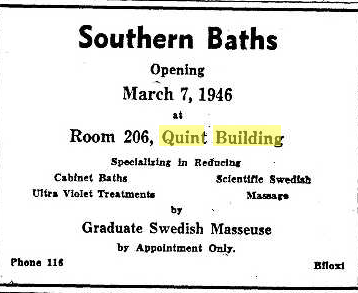
Southern Baths
After getting settled at Biloxi, Lotty Moore Schoemmell opened on March 7, 1946, for its time and place, a unique business, the Southern Baths. It was situated in the Quint Building on Lameuse Street and Howard Avenue. Lotty specialized in weight reduction and offered cabinet baths, ultraviolet treatments, and a scientific Swedish massage by a graduate Swedish masseuse. [The Daily Herald, March 4, 1946, p. 7]
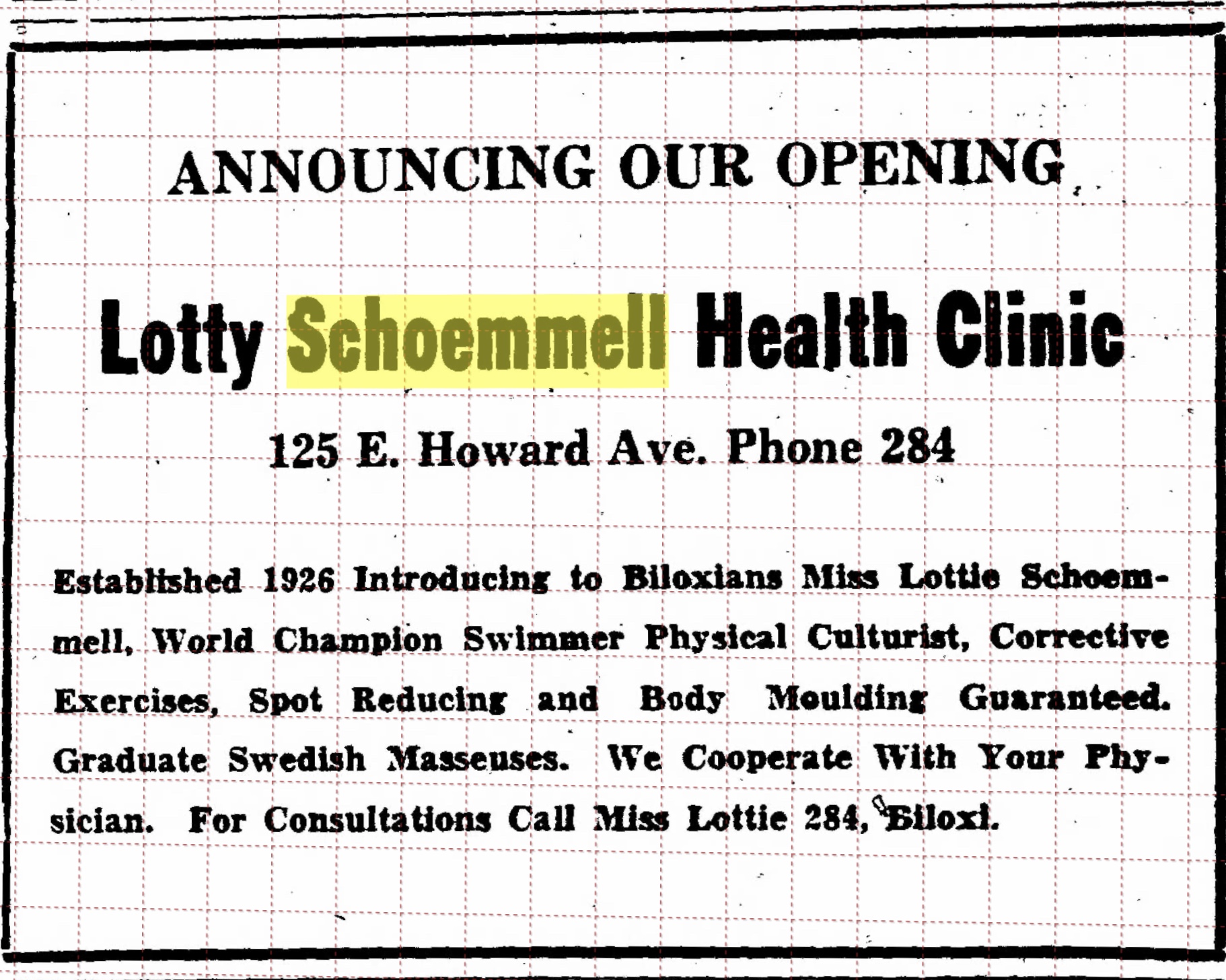
Schoemmell Health Clinic
In early November 1946, Lotty rebranded herself as the Schoemmell Health Clinic at 125 East Howard Avenue, which was probably in the Quint Building. Calling herself Miss Lotty, she advertised her business as having been established in 1926 and that she was a World Champion swimmer, Physical Culturist and graduate Swedish masseuse. Lotty offered her potential clients the following services: corrective exercises, spot reducing, and body moulding. She reassured her patients that she would cooperate with their doctors.[The Daily Herald, November 8, 1946, p. 8]
By December 1946, the Schoemmel Health Clinic had relocated to the Jordan-Schwan building at 216 West Howard Avenue.[The Daily Herald, December 28, 1946, p. 7]
1947
Red Cross instructor
During the summer of 1947, the Biloxi chapter of the American Red Cross hired Mrs. Schoemmel to instruct the youth of Biloxi in the art of swimming and water safety. The afternoon classes were held at the Buena Vista Hotel. Miss Eleanor Wiltz was the Red Cross contact in their office on Lameuse Street and Water Street. Beginners who had completed the course were: Donald Balius, Barbara Knebel, Curtiss Neilson, Donald Walters, Benda Walter, Carol Walters, Lell Thompson, Donald Rich, John Robinson, Jimmy McNaughton, Mary Ann Gillis, June Juanico, Jerry Juanico, Beverly Jean Lenox, Shirley Foale, Oscar DeWitt, Patricia Trexler, Shirley Trexler, and Rudell Bounds.[The Daily Herald, July 12, 1947, p. 6]
In early July, while teaching a beginner’s swim class, Lotty rescued a lady tourist whose screams were heard by those at the Buena Vista Hotel pier. She also brought in three frightened children who wandered into deep water and need assistance.[The Daily Herald, July 2, 1947, p. 7]
At this time, Ms. Schoemmell would also teach Junior and Senior Life Saving courses at the Buena Vista Hotel.[The Daily Herald, August 21, 1947, p. 6]
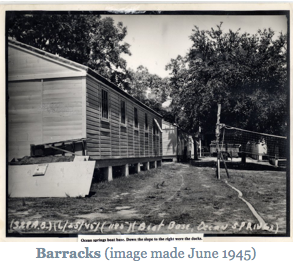
Lotty M. Schoemmell acquired one of the US Army Air Corps barracks as her residence in July 1947
Ocean Springs
Lotty Moore Schoemmell acquired in July 1947 a lot and building on Hellmer’s Lane situated on the Ocean Springs Harbor. Lulu Bell Haviland Clark [1880-1972], the widow Charles E. Clark [1879-1945], was the vendor.[Jackson Co., Mississippi Land Deed Bk. 111, pp. 396-398]
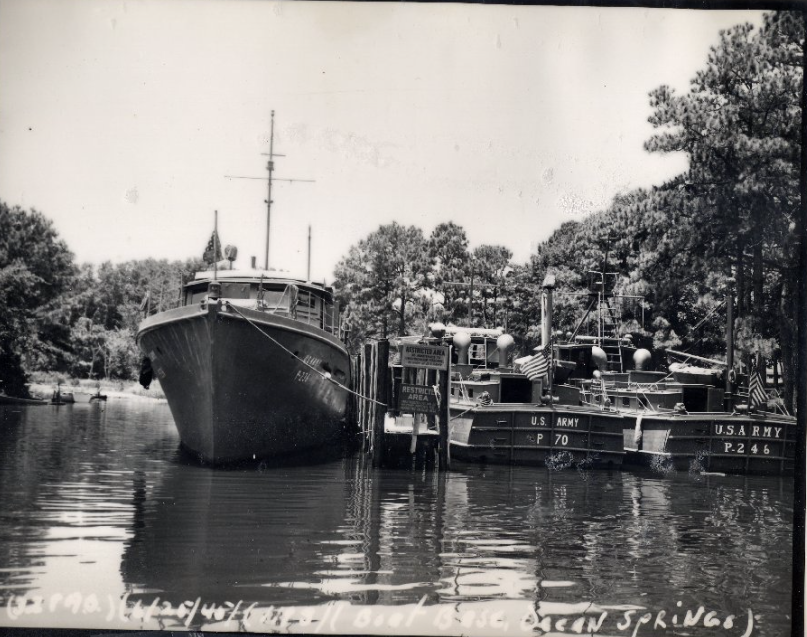
US Army Air Corp Crash and Rescue Boat Base-This extremely rare image was made in late June 1945 after the US AAC base had been abandoned. In early 1944, the base opened on Hellmer’s Lane on the north side of the Ocean Springs Inner Harbor to provide aviators training in B-17s and B-24s at Gulfport AAF before they were sent to war. Five crash boats were moored at the Ocean Springs base and on stand by to rescue downed airmen who trained over the Gulf of Mexico. In 1947, Lotty Moore Schoemmell [1895-1966] acquired one of these buildings and lived here until she moved in 1958 to a trailer on the Old Spanish Trail about 2 miles east of town.[Courtesy of Guy L. Gammon [1916-2011], a great American who served here during WW II]
Crash Boat Base
For one possessed of determined individuality and unique athletic prowess, Ms. Schoemmell had chosen an ideal location to live. Here in a serene neighborhood with waterfront access to Biloxi Bay and the Mexican Gulf, she must have found her “le joie de vivre”.
Lotty’s residence had recently been a part of a US Army Air Corps Crash and Rescue Boat Base. Here in late 1943, U.S. Army Air Corps personnel from Key Field at Meridian, Mississippi were sent to man the nascent facility on the inner harbor. B.L. Knost Company of Pass Christian, Mississippi was awarded a $14,730 contract to build pre-fabricated barracks, a mess hall, and lavatory on Hellmers Lane on the north shore of the inner harbor.(The Jackson County Times, December 11, 1943, p. 1)
A.P. ‘Fred’ Moran [1897-1967], Beat Four County Supervisor, committed Wahalak, the Jackson County dredge, to excavate slips for the 3rd Air Force crash boats. These small, swift watercraft were used to monitor bombing ranges in the Gulf of Mexico and assist downed flyers.(The Jackson County Times, January 15, 1944, p. 1)
The US Army Air Corps base at Ocean Springs was called Main Base as other crash boat sites under the aegis of the Gulfport AAF, were called Sub-Bases, and situated at: Municipal Field, New Orleans; Brookley Field, Mobile, Alabama; and the Old Gulfport Yacht Club Pier, Gulfport, Mississippi. In December 1944, there were five boats assigned to the Ocean Springs base. They were as follows: P-236, a 104-foot Sea Going Rescue Boat; P-70, an 83-foot Sea Going Rescue Boat; P-726, a 63-foot Sea Going Rescue Boat; P-246, an 83-foot Sea Going Rescue Boat (not operational); and P-54, Army Crash Boat (not operational).(IRIS Roll No. B2251, p. 804)
After V-J Day on September 2, 1945, activity at the US Army Air Corps crash boat base began to diminish rapidly. The rescue vessels at Ocean Springs were moved to Brookley AFB, Mobile, Alabama. By March 1946, the military facility on Hellmer's Lane was still open, but not operational. It was permanently closed shortly thereafter.(W.H. Yarrow, Hattiesburg, Mississippi, April 10, 1999)
The Inner Harbor at Ocean Springs moored and sheltered over two hundred Biloxi shrimp boats from the September Storm. Their vessels were valued at $1,000,000.(The Jackson County Times, December 1947, p. 1 and The Daily Herald, May 9, 1957)
1948
To make a living at Ocean Springs, Lotty taught swimming lessons to children and adults at the Community Pier on Front Beach near Martin Avenue. She also had classes in Biloxi at the Buena Vista Hotel Pier. Miss Schoemell charged $3 for a lesson and for $25 one would receive 10 private sessions from this world class swimmer.[The Jackson County Times, June 25, 1948, p. 4]
Taxidermist?
Pat Murphy [b. 1928], native of Ocean Springs, related to Ray L. Bellande in mid-September 2020 that while hunting, he killed a bobcat. He brought the animal's remains to Lotty and asked her to preserve it as a hunting trophy. She told Pat that the head was badly damaged by pellets from the shot. Lotty gave him the bobcat's pelt as his souvenir and it was used as a small rug in the Murphy home.[Pat Murphy, September 19, 2020]
1955
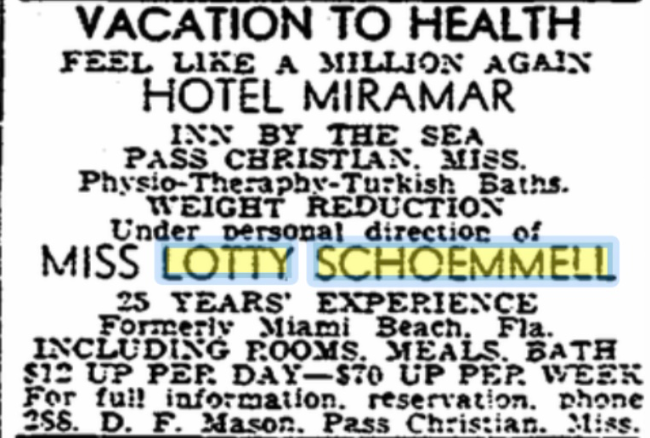
[The Times-Picayune, November 6, 1955, Section 5, p. 1]
To make a living at Ocean Springs, Lotty taught swimming lessons to children and adults at the Community Pier on Front Beach near Martin Avenue. She also had classes in Biloxi at the Buena Vista Hotel Pier. Miss Schoemell charged $3 for a lesson and for $25 one would receive 10 private sessions from this world class swimmer.[The Jackson County Times, June 25, 1948, p. 4]
1950
Lotty ran this advertisement in 1950: Swedish Massage-Theropeutic [sic] treatments for arthritic, rheumatic, nervous, tired and overweight patients, given at your home, by nurse Miss Lotty Schoemmell. 24 years experience. Office at General Pershing and Inner Harbor, Ocean Springs. P.O. Box 8, Ocean Springs.[The Chronicle-Star [Pascagoula], September 1, 1950, p.12]
1954 Yard Sale
In early 1954, it appears that Lotty was preparing to relocate. These advertisements demonstrate this especially the sale of her skiff and outboard motor: 7.5 HP Elgin motor $75. 14-foot skiff, $35. Perfect Condition. Ocean Springs. 12-foot skiff and oars, $35. Wheel Chair. Gas lawn mower, $80. New Admiral vacuum cleaner and attachments, $50. Lotty Schoemmell, Inner Harbor, Ocean Springs.[The Daily Herald, February 17, 1954, p. 18 and March 27, 1954, p. 14]
House For Sale-Bargain
In the summer of 1954, Mrs. Schoemmell offered her home on the Inner Harbor at Ocean Springs for sale. She advertised as follows:
Water frontage 75 feet on Inner Harbor, Ocean Springs. 150 feet on Street [Hellmer’s Lane] by 214 feet into Harbor. House 48 feet long by 20 feet wide. $6000 cash. Will take back first mortgage $2000. Total price $8000. Must be sold this week. Tel. Ocean Springs 7560 for appointment. Lotty Shoemmell.[The Daily Herald, August 3, 1954, p. 3]
Quit Claim Deed
Lotty was unable to sell her former US Army Air Corps building-residence on the Ocean Springs. On August 15, 1947, she executed a quitclaim deed to Lulu Clark Haviland. Lotty’s luck had just improved because the September Storm, a powerful hurricane, ravaged the Mississippi Coast in mid-September 1947. We await Hurricane Sally, a Category 2 storm, that will certainly affect Ocean Springs and its harbor.[Jackson Co., Mississippi Land Deed Bk. 111, p. 205]
In 1964, Alice P. Duckett, who resides at 1406 Hellmer's Lane, acquired one of the former military barracks, when she purchased the onetime residence of Miss Charlotte "Lotty" Moore Schoemmell (1895-1966). Mrs. Schoemmell had procured the lot and building in July 1947, from Lulu Haviland Clark, several years after the US AAC crash boat base was closed. A. Bruce Duckett Jr. removed the former Schoemmell residence from Hellmer's Lane to 916 Calhoun, which ironically is just east of the old Henry Hellmers home near the St. Alphonsus Catholic Church.[Alice P. Duckett, April 9, 1999]
1958
In September 1958, Lotty acquired three lots [10, 11 and 12] in the Bryan Farms Subdivision on the Old Spanish Trail [US Highway 90] from Georgette F. Lee [1889-1979]. Here she resided in a 1955 New Moon house trailer [41 feet by 8 feet].[Jackson Co., Mississippi Land Deed Bk. 184, p. 433]
1959
Lotty must have become bored with life at Ocean Springs, now a grandmother of three, she began dreaming of again becoming a competitor. Her first scheme was to swim down the Mississippi River from a city north of NOLA. Zan Skelton, acclaimed BHS English teacher, interviewed Lotty in June 1959. She related to him that with a sponsor an attempt to paddle down the Great River, an idea first conceived in 1927, could be achieved. Lotty never found the sponsorship needed to finance her swim.[The Daily Herald, June 18, 1959, p. 17]
1960
In the spring of 1960, Lotty created another idea to get back in the game. She challenged William “Bill” J. Mihalo [1915-1979], a native of Centerville, Iowa and a former national champion, long distance walker to a race down the Mississippi River from St. Louis to NOLA. Lotty estimated the swim would be about 1000 miles because of the meandering of Ole Man River. The challenge was not accepted.[The Daily Herald, March 26, 1960, p. 2]
1962
Another marathon swim?
In the spring of 1962, Lotty M. Schoemmell became enamored to attempt another swim from Santa Catalina Island to the California mainland, a linear distance of about 22-miles. She had failed the treacherous Catalina Channel attempt twice in 1927. Her agent, Captain George H. Maines [1887-1970], a Hollywood talent scout, said of Lotty’s aspiration as follows: “Lotty is ready to give it another try. She has been toying with the idea for several years.” It was reported at this time that Ms. Schoemmell had traveled to Long Beach, California to train for the channel swim. There is no record of an attempt.[The Chronicle-Star, [Pascagoula, Mississippi], May 24, 1962, p. 25]
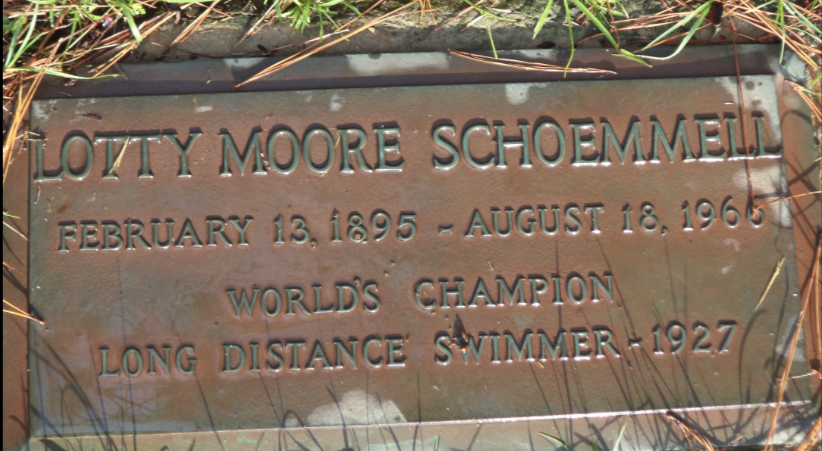
1966
Charlotte “Lotty” Moore Schoemmell expired on August 18, 1966 while walking on the Old Spanish Trail [US Highway 90] about 2 ½ miles east of Ocean Springs. A coroner’s jury inquest determined that her death was the result of natural causes. Her corporal remains were interred in Crestlawn Memorial Park cemetery at Ocean Springs, Mississippi.[The Daily Herald, August 18, 1966, p. 2]
1967
Lotty Moore Schoemmell was posthumously, elected to the International Marathon Swimming Hall of Fame in 1967. Her class included the following marathon swimming icons: Marilyn Bell; the Cavill Family; Juan Jose Cortinas; Horacio Iglesias; and Keo Nakama. Their website offers this information of Ms. Schoemmell’s accomplishments as an international swimmer: Charlotte “Lottie” Schoemmell swam 251 km (156 miles) down the Hudson River in New York, USA in 1926 in 57 hours and 11 minutes over an 11-day period, eating lumps of sugar soaked in whiskey while in the water. The swim was covered extensively by the media. She also swam around Manhattan Island in New York in 14 hours and 21 minutes in 1926 and nearly finished the 1927 Wrigley Ocean Marathon from Catalina Island to the California mainland, USA. She was also on the Board of Governors in 1927 of the International Professional Swimming Association with eight other IMSHOF honorees.[imshof.org]
Lotty's 1967 IMSHOF Class
Marilyn Bell [b. 1937], at age 16, was the first person to swim 51.4 km (32 miles) across Lake Ontario in 1954. This 20 hours and 59 minutes swim dominated Canadian news, she collected a $10,000 prize, a park was named in her honor and she was named Canadian Newsmaker of the year. As a 17-year- old, she became the youngest English Channel swimmer for a period of eight years. She swam from Cap Gris Nez, France to East Wear Bay, England in July 1955 in 14 hours and 36 minutes. Marilyn completed two other major epic marathons: 37 km Atlantic City Around the Island race in 1954 in 10 hours 7 minutes and 16.8 km Strait of Juan de Fuca in 1956 in 10 hours and 38 minutes.
The Cavill Family consists of two generations of six colorful champion swimmers (1897 – 1938) who promoted swimming and set national and regional records. Fred (Father): Royal Humane Society, received four medals for life saving; missed completing English Channel swim by 50 yards when boatman refused to land at night. Ernest: World record holder in the 1000-yard freestyle and “World Title” series winner in England against American champion McCusker. Charles: First man to cross the Golden Gate. Percy: Won 4 Australian National Championships and set world records in the 440 yards and 5-mile freestyle. Taught swimming for 15 years in America; Arthur: Stunt swimmer who crossed rivers with both hands and feet tied. He died from exposure, attempting to swim across Seattle Harbor. Syd: Won 1 Australian Championship and coached at San Francisco Olympic Club. Dick: Won 18 Australian titles and 2 English titles. Toured America as Father Neptune in a stage act and was influential in the development of independent arm stroke and leg kick of the crawl stroke. Died of a heart attack during a swimming demonstration in 1938. They were also inducted into the International Swimming Hall of Fame (1970).
Juan Jose Cortinas was born in 1916. He successfully completed the crossing of Gibraltar strait, twice across the Catalina Channel and from Alcatraz to San Francisco in 1 hour and 14 minutes with bounded legs and handcuffed and many other swims, When Fidel Castro came into power he could not stand to be restricted to Cuba Island so he tried twice to escape swimming across Florida Strait, but was caught both attempts by the Soviet Navy. José was kept behind the bars in Cuba as a political prisoner until his death.
Horacio Iglesias, known as Dorado, was the World Professional Marathon Swimming Federation world champion in 1967, 1969, 1971 and 1972. He was runner-up in 1968 and 1970. He won the 24-hour La Tuque relay swim six times with three different partners, including Egypt’s Abou- Heif and Holland’s Judith DeNys. He also won the 34 km (21-mile) Traversée internationale du Lac St- Jean professional race in Canada in 8 hours 55 minutes in 1967, in 9 hours 31 minutes in 1968, in 9 hours 32 minutes in 1969, in 8 hours 39 minutes in 1971 with a second in 1970, and excelled in the warm-water professional swims in South America. He won the 37 km (23-mile) la Descente ou remontée du Saguenay in 6 hours and 3 minutes in 1967 and was fifth in 9 hours 22 minutes in 1968. He was also honored by the International Swimming Hall of Fame as an Honor Open Water Swimmer (2003).
Keo Nakama was the first person to swim from the island of Molokai to Oahu in Hawaii. He crossed the 43.4 km (27-mile) Kaiwi Channel in 1961 in 15 hours and 30 minutes. As a pool swimmer, Keo is honored in the International Swimming Hall of Fame (1975) for his 5 gold medals in the 1940 Pan American Swimming Championships, his 27 USA national swimming titles from 110 yards to 1500 meters, his six Australian National Championships and his world record in the mile and for captaining the two NCAA Men’s Swimming Championship teams at Ohio State where he also played baseball.
SCHOEMMELL DATES
Lotty C. Moore married Martin Schoemell Jr. in Bronx County, New York on October 12, 1914.
Divorced in Dade County, Florida in 1942.
Martin Schoemell Jr. [1881-1963] born Bronx-September 2, 1881. died Gulfport, Florida on August 7, 1963.
CHILDREN
Martin Wooderd Schoemmell [1915-1915] born Bronx-September 5, 1915 to October 27, 1915.
Harold LeRoy Schoemmell [1916-1989] born Bronx-October 25, 1916. died September 2, 1989.
Married on January 10, 1940 to Mary Agnes Veverka [1918-2004], daughter of John J. Veverka [1892-1941] and Agnes Monohan
Ruth Grace Schoemmell [1919-1988] born Bronx- May 13, 1919 died at Clearwater, Florida on June 20, 1988.
REFERENCES:
Judith Jenkins George, The Fad of North American Women’s Endurance Swimming during the Post-World War I era, Depauw University,
The Beaumont Journal, ‘Galveston lifeguard in Gulf swim Sunday’, May 10, 1946.
The Berkley Daily Gazette, ‘Speaking of Sport’, June 20, 1930.
The Boston Herald, ‘The Frail Sex’, November 22, 1926.
The Chicago Daily News, ‘Noted swimmer aid shoe fund’, April 11, 1930.
The Daily Herald [Biloxi, Mississippi], ‘Many to witness Marathon Event’, August 7, 1928.
The Daily Herald, ‘Schoemell Health Clinic’, January 2, 1947.
The Daily Herald, 'Would like to swim down Mississippi River', June 18, 1959, p. 17
The Daily Herald, 'Know Your Coast-"Still a Champion after 30 years', December 27, 1959.
The Daily Herald, ‘Distance swimmer issues challenge to walker for race down Old Man River”, March 26, 1960.
The Daily Herald, ‘Famed swimmer found dead in Ocean Springs’, August 18, 1966.
The Greensboro [North Carolina] Record, ‘New York day by day’, October 18, 1932.
The Houston Chronicle, ‘SWEA Health Institute’, November 20, 1945.
The Houston Chronicle, ‘Five-Mile swim to feature splash day at Island today’, May 12, 1946.
The Jackson County Times [Ocean Springs, Mississippi], ‘Lotty Schoemmell, noted swimmer, to give Red Cross life saving lessons', June 18, 1948.
The Jackson County Times, ‘Learn To Swim’, June 25, 1948.
The Gulf Coast Times [Ocean Springs, Mississippi], ‘Lottie [sic] Schoemmell, Champion swimmer recalls days of great long distance feats', April 19, 1951.
The Gulf Coast Times, 'Local Swimmer's feat recalled', September 18, 1952.
The Kingston [New York] Daily Freeman, ‘Swimmer wears only grease’, October 14, 1926.
The Ocean Springs News, “Suits off Ladies’, September 17, 1964.
The Ocean Springs Record. ‘Famed swimmer found dead’, August 25, 1966.
The Post Herald [Beckley, West Virginia], ‘Gertrude Ederle takes 18 miles practice swim’, June 16, 1925.
The Reno Evening Gazette, ‘Fierce fish bite woman swimmer but in vain’, February 7, 1927.
The Richmond Times Dispatch, ‘Woman, Handcuffed, swims North River’, October 21, 192
The Riverside [California] Daily Press, ‘Swimmer will enter contest for rowing’, May 5, 1927.
The Santa Ana [California] Daily Register, ‘Freezing waters bring no chill of fear’, December 2, 1926.
The Santa Ana [California] Daily Register, ‘Famed Mermaid enters rowboat race to island’, May 5, 1927.
The San Antonio Light, ‘Gentry wins 5-mile swim’, May 13, 1946.
The Sarasota Herald, ‘Ms. Corson’s swim record is shattered’, October 21, 1926.
The Sioux City Journal, ‘Woman who swam Gibraltar gets Royal welcome’, April 10, 1928.
The Trenton Evening Times, ‘Flashes of Life’, August 20, 1927.
The Winona [Minnesota] Republican Herald, Swimming made hard’, October 18, 1927.